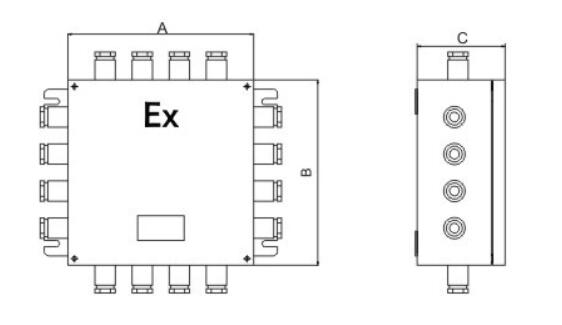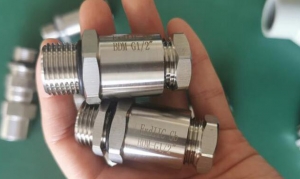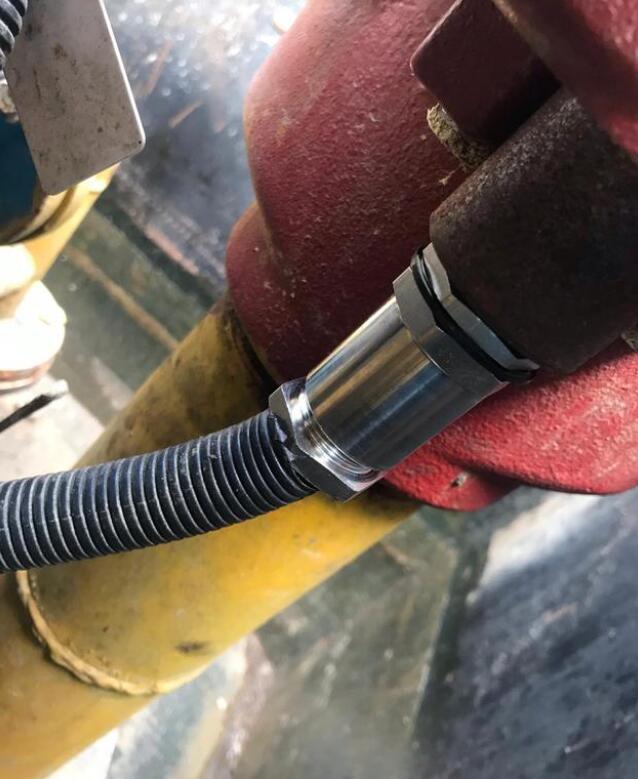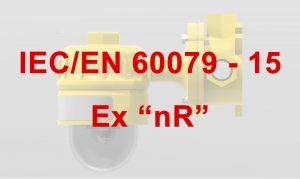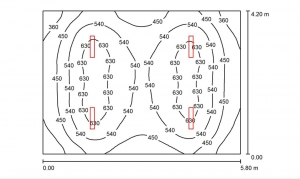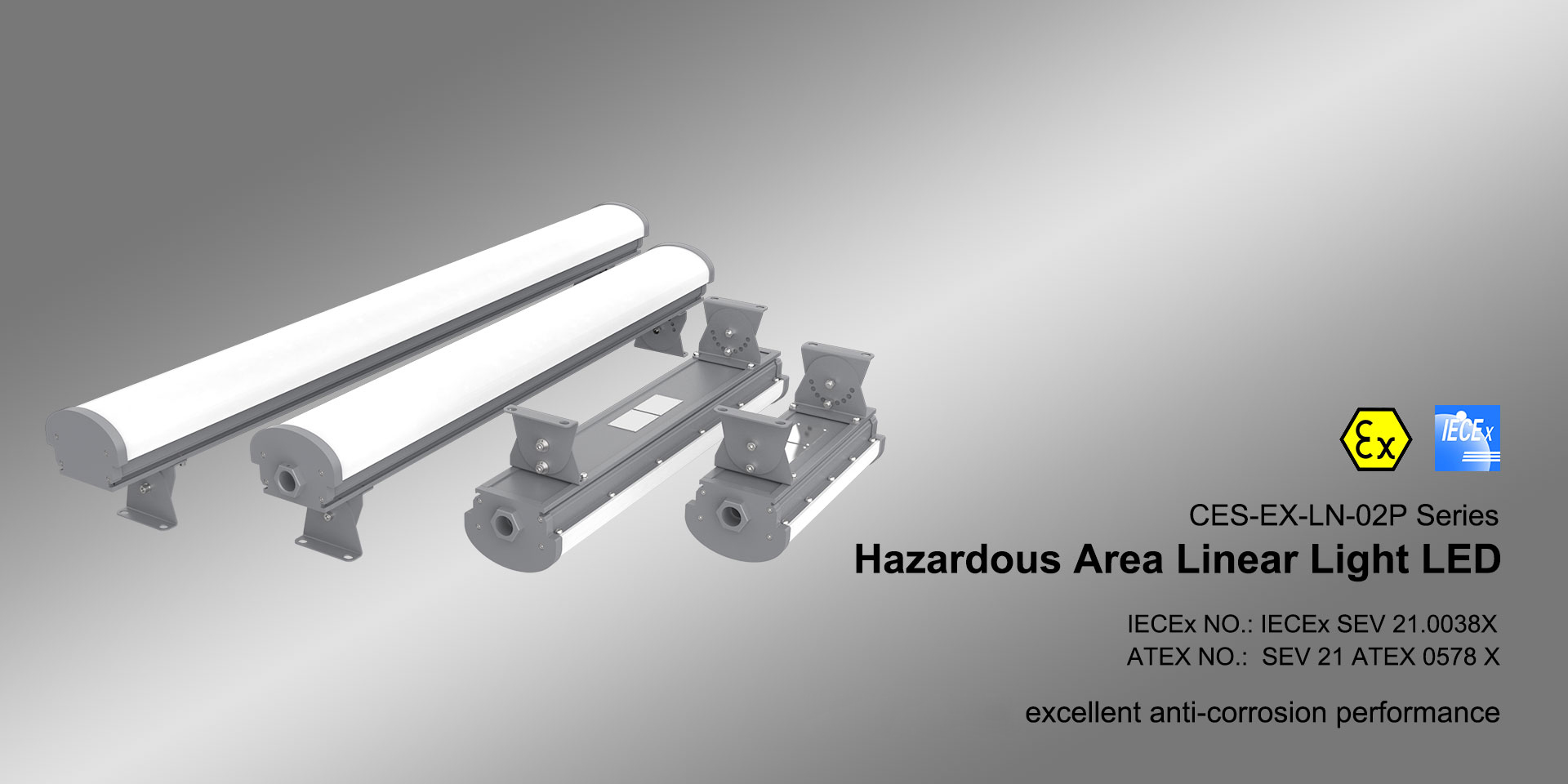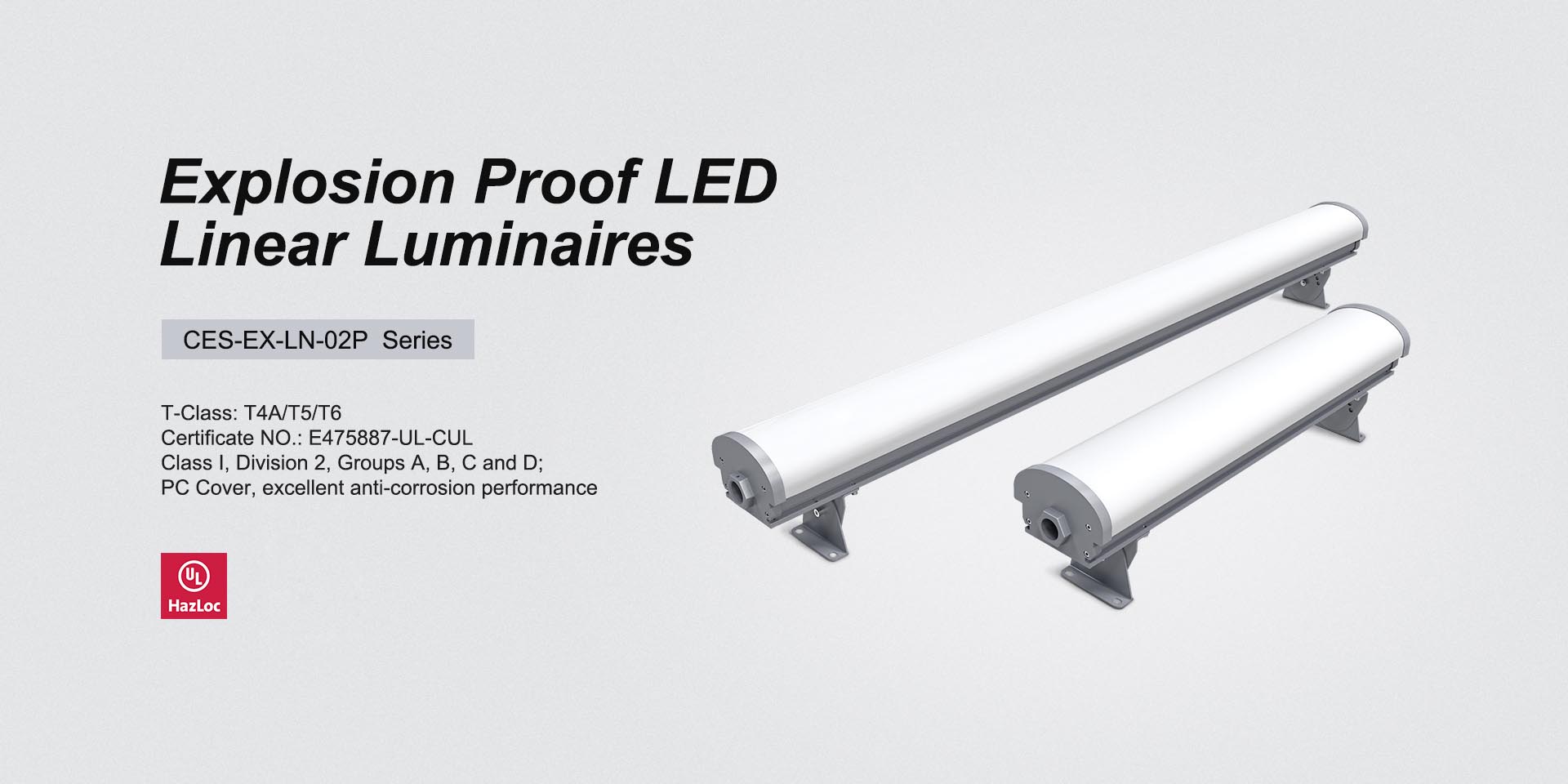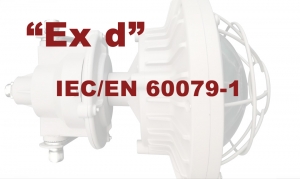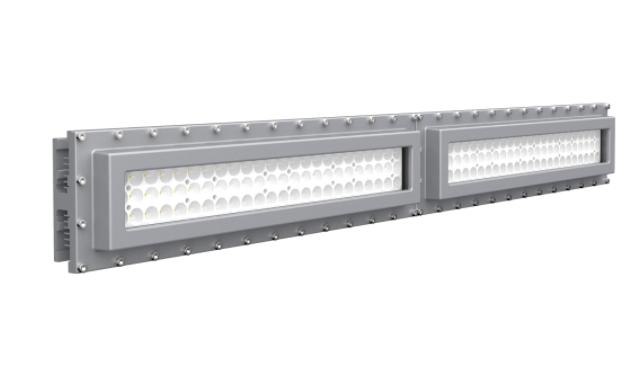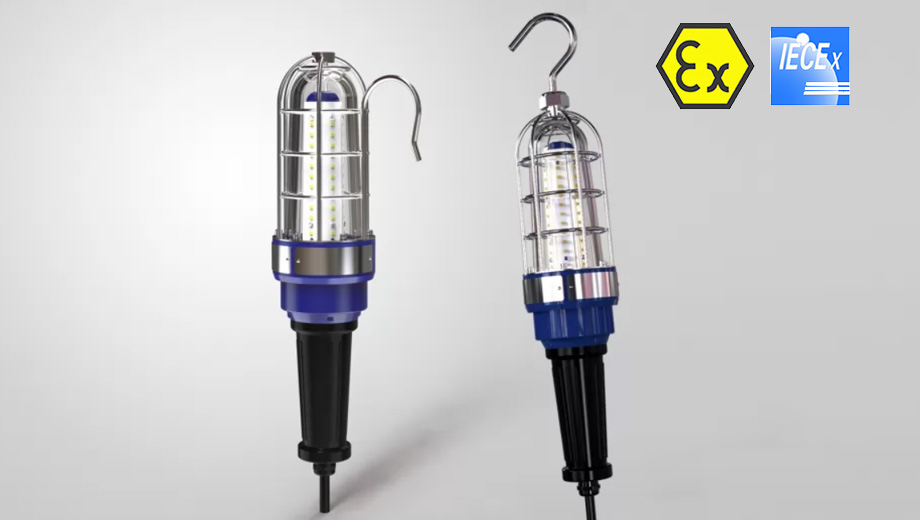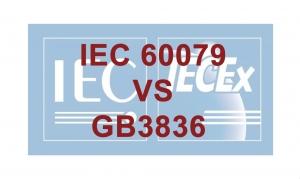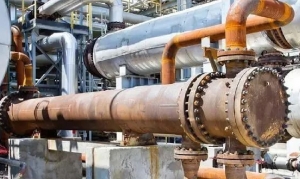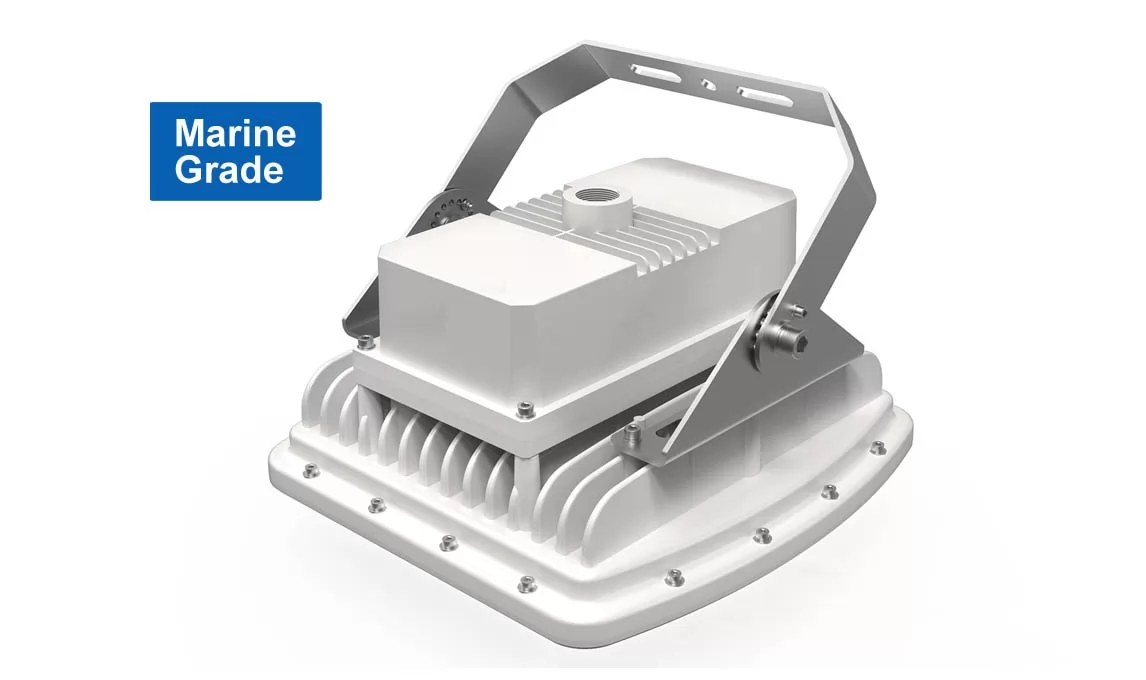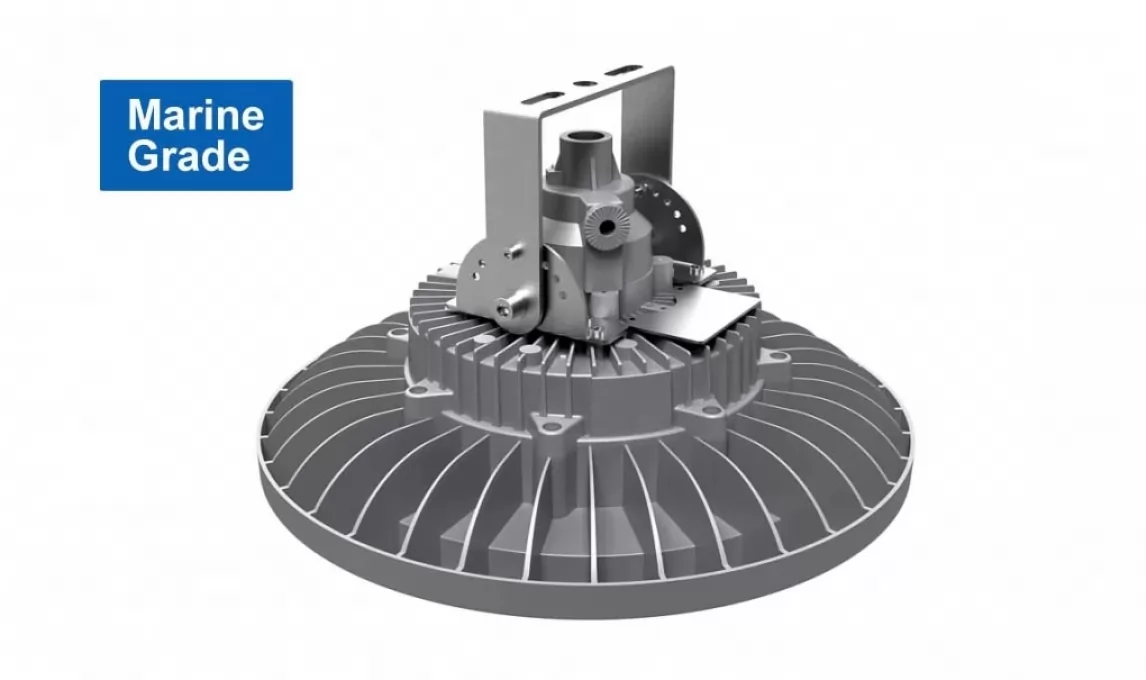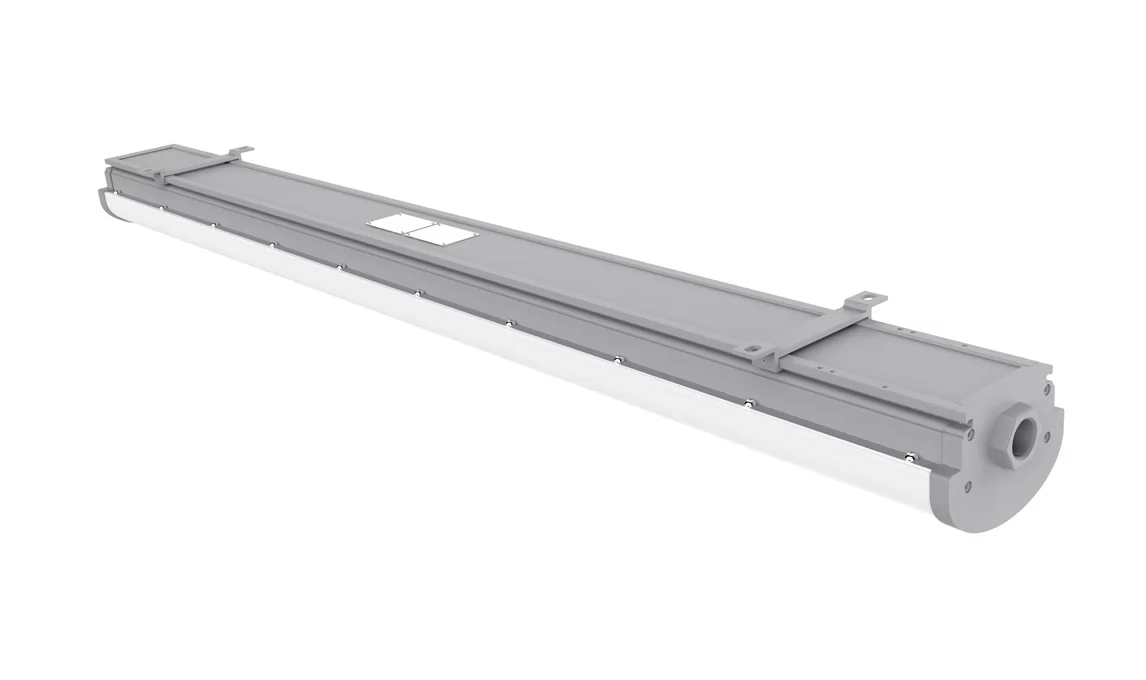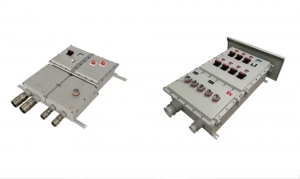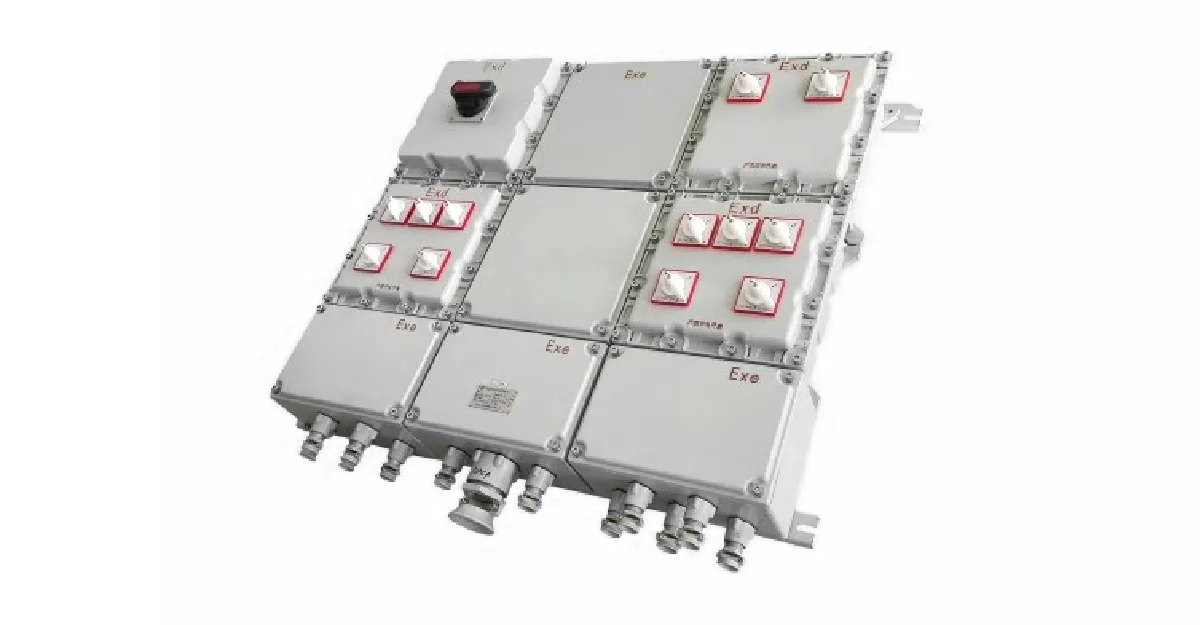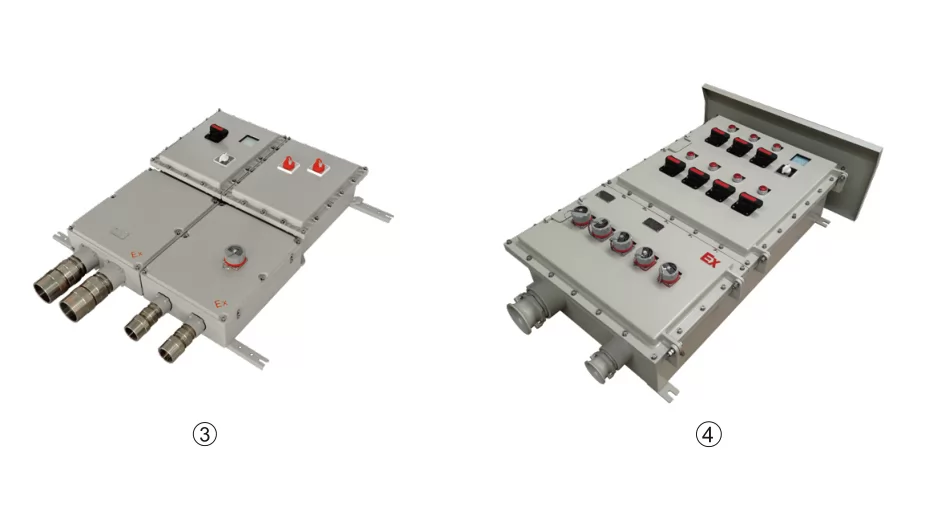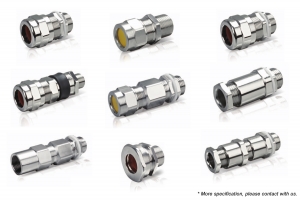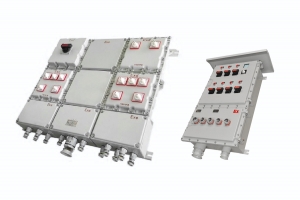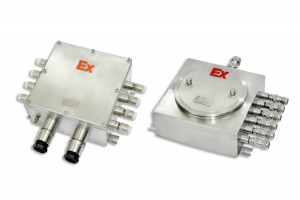Explosion-proof cable gland types
Explosion-proof sealing connector are also called explosion-proof cable glands, which are used for tightening and sealing of cables of explosion-proof equipment.
Thread specifications are divided into the following four types:
Metric M thread, German PG thread, American NPT taper thread, Imperial G(PF) pipe thread
The most common demand is M thread. Among the specifications, M12, M20, M25, M32, M63, M72, M75, etc., the common pitch is 1.5 and 2.
There are also some threads that are not conventional and need to be customized, such as reducing-diameter explosion-proof cable glands. The specifications at both ends are customized according to the interface specifications of the introduction device of the explosion-proof equipment on site.
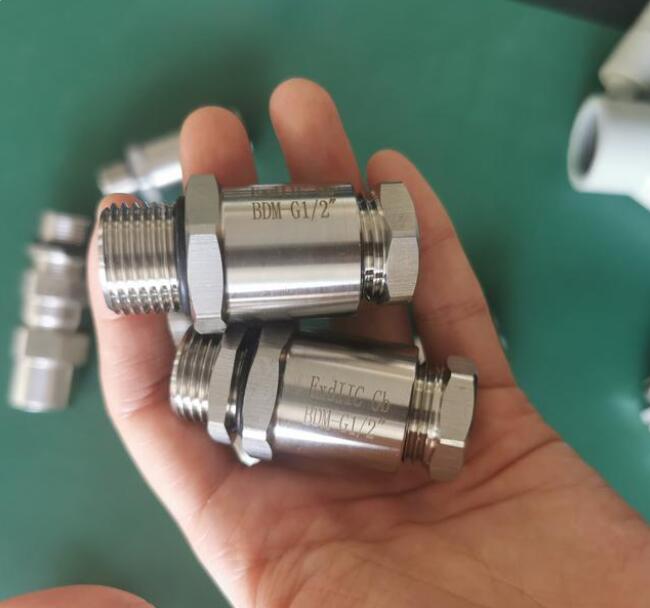
For unconfirmed specifications and sizes that need to be purchased, you should confirm with the seller, because generally non-standard customized specifications of explosion-proof cable glands cannot be returned after sale, so if the purchase quantity is large, it is best to order samples to confirm that they are correct, and then place bulk orders.
The product is generally made of S304 stainless steel, with unique explosion-proof function, special design of clamping melon and clamping ring, large clamping cable range, strong tensile strength, waterproof, dustproof, salt resistance, weak acid resistance, Alcohol, oil, fat and general solvents.
The following is the size comparison table of inch thread (G), metric thread (M), American thread (NPT) and German thread (PG)
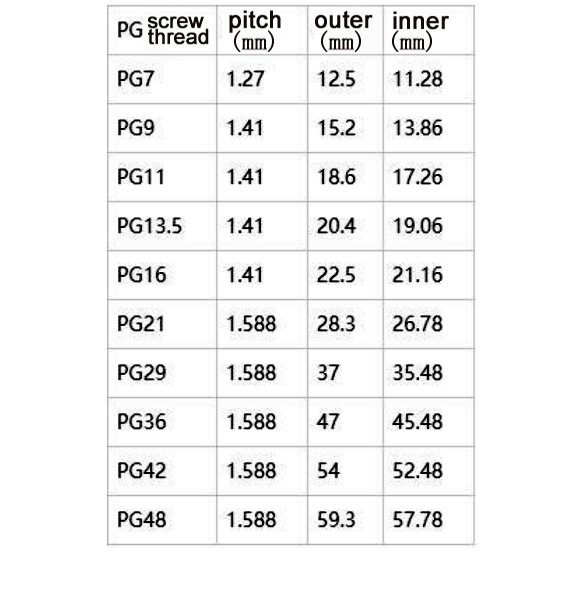
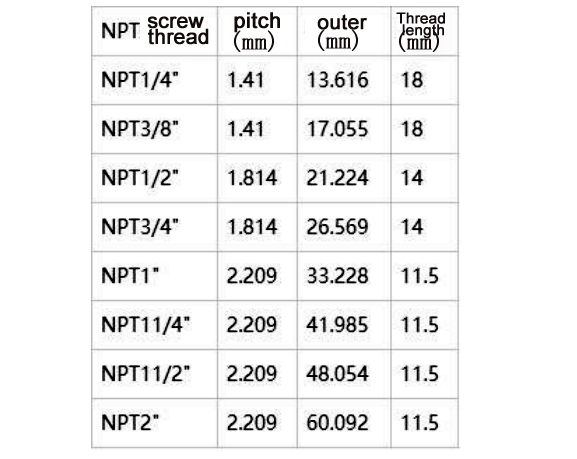
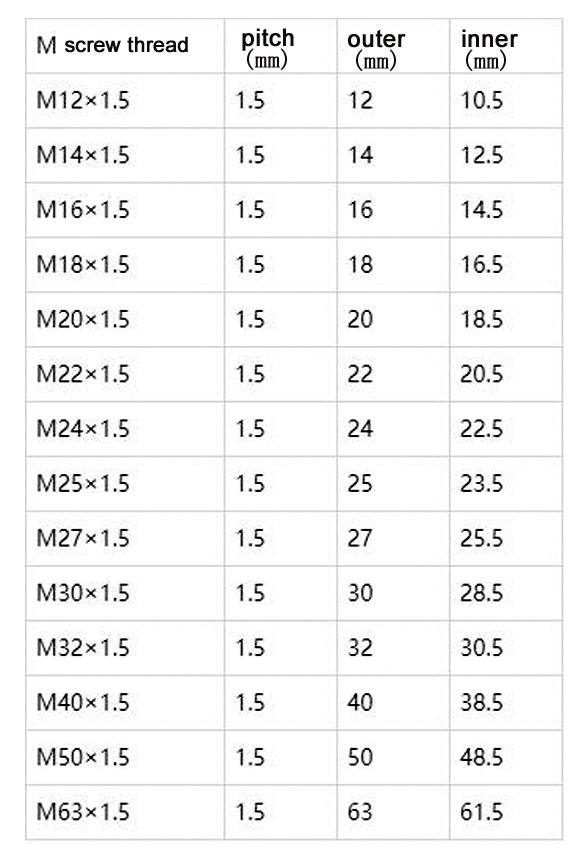
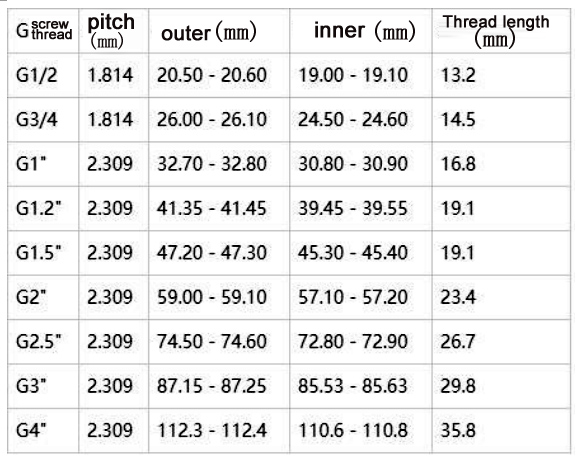
CESP provides customized explosion proof cable glands of 316 stainless steel, high temperature resistant, flame retardant, etc. Protection level: within the specified bayonet range, and use the sealing ring to tighten the tightening head to reach IP68-5 Bar.
Welcome to contact us!
How to design the retricted breathing lamps (ex-proof “nR”)
Restricted breathing lamps are a kind of "n" type explosion-proof products. They are used in enviroment with potentially explosive gas atmospheres in Zone 2. They are the same as increased safety lamps in terms of use, but their light source types are higher than that of increased safety lamps. The weight is lighter than that of flameproof lamps, but the scope of use is not as wide as that of flameproof lamps. It has the characteristics of light weight and various types of applicable light sources. It is undoubtedly an economical and easy-to-use product for use in places where good lighting is required in zone 2.
According to IEC/EN 60079-15 Type of Protection “ n ”
Electrical installations designed so that ignition is unlikely to occur in normal or abnormal operation. The gas explodes. The main protection methods are classified as follows.
- nA: Non-Sparking
- nC: Enclosed-Break (blocked), Hermetically-Sealed (metallicor glass tight seal), Non-Incendive (non-incendive), Sealed device (sealed)
- nR: Restricted Breathing Enclosure
This new type of product has many novelties in explosion-proof mechanism, characteristics, inspection difficulties and design. Only when designers and users understand these can they be well designed and used.
Part.1 Explosion-proof mechanism for the Restricted breathing lamps
To understand the explosion-proof mechanism of the restrictive breathing lamp, we must first understand where it is used, and understand where to start with this product to consider the explosion-proof structure treatment.
Restricted breathing lamps have certain restrictions on the use of this kind of lamp, which is only allowed to be used in places with potential explosion hazard gas environment 2, that is to say, the place where this lamp is used is relatively less dangerous. In normal operation, there are no explosive hazardous substances in the environment, including gases, vapors and mist, and dangerous explosive gases, vapors or mist will appear only when they fail, and the chance of such failure is very small, and even if there is a failure, the time of failure is very short. It is precisely because of the particularity of the use environment that this kind of lamp only needs to prevent the danger of dangerous substances in rare cases and the duration of dangerous substances is extremely short. Therefore, the shell of this kind of lamp is to limit the amount of gas, vapor and mist entering, rather than preventing gas, vapor and mist from entering.
When the lamp is working normally, the calorific value of the internal light source is relatively high, which will cause the internal gas to expand and form a positive pressure in the light source cavity of the lamp. Due to the formation of positive pressure, the internal gas leaks out. When the lamp is out of use, the inside of the lamp will gradually cool down. At this time, due to the temperature drop in the lamp, the gas volume is reduced. At this time, the air volume in the lamp is smaller than that in the initial state of the lamp, which causes the inside of the lamp. of negative pressure. If the lamp does not take protective measures, and an accident happens at this time, there is a leakage of dangerous substances, then the dangerous substances may enter the lamp. When the lamp is used again, the high temperature inside the lamp may ignite the explosive gas, vapor or mist existing in the lamp, resulting in a dangerous accident. Restricted breathing lamps are based on this characteristic of lamps, and the light source and its related electrical components are put into restricted breathing enclosures. A restricted breathing enclosure is a type of enclosure that restricts the entry of gases, vapors and mists. That is to say, a restricted-breathing luminaire is a luminaire product with a special housing. This product increases the ability of the housing to restrict the ingress of gases, vapors and mists, so hazardous substances do not enter the luminaire for a short period of time. Of course, if the accident lasts for a long time, there will be danger. Therefore, for this kind of lamps, corresponding measures have been taken to further increase the safety. First of all, its use place is limited, and it is only allowed to be used in Zone 2, so that due to the short maintenance time of the accident, the number of accidents is less, and the chance of danger is reduced. At the same time, strict performance inspections have been carried out for the dangerous components in the casing, such as ballasts, lamp sockets, starters, etc., to ensure the safety and reliability of the components. In this way, this explosion-proof lamp is safe.
Before the emergence of restricted breathing lamps, there were two commonly used lamps in the explosion-proof lamps family: explosion-proof lamps and increased safety lamps. Explosion-proof lamps can be used in areas with potentially explosive gas atmospheres in Zone 1. This kind of lamp mainly uses the high strength and explosion-proof property of the product shell to achieve the purpose of explosion-proof, allowing accidents in the surrounding environment and dangerous substances in the lamp. It uses the strength of the lamp shell to prevent the pressure generated by the internal explosion of the lamp from damaging the lamp body and ignites the surrounding environment, and at the same time uses the extremely small gap between the metal joints of the shell to prevent the flame in the lamp from igniting the surrounding flammable substances; Lamps are also a kind of explosion-proof lamps that are widely used. This kind of lamps is designed by adding a series of safety measures, such as increasing the electrical clearance and creepage distance, increasing the protection level of the shell, and using explosion-proof lamps where sparks may occur in the lamps. Measures to deal with, limit the temperature level of lamps, etc. to achieve safety purposes. In my country, most of this type of explosion-proof lamps are used in Zone 2, and only increased safety single-plug fluorescent lamps are allowed to be used in Zone 1.
Through the above description, it is not difficult to find that the restricted-breathing lamps achieve the purpose of explosion-proof by restricting the entry of explosive gas, vapor or mist into the interior of the lamp body through the good sealing of the shell; And high-strength shell to achieve the purpose of explosion-proof; increased safety lamps and lanterns by increasing the safety of the lamp itself to achieve the purpose of explosion-proof lamps. Therefore, these three lamps each have different characteristics.
Part.2 The Feature of the Restricted breathing lamps
Through the description of the explosion-proof principle of restricted-breathing lamps, it is not difficult to find that restricted-breathing lamps mainly improve the reliability of internal components, at the same time increase the protection capability of the shell, and limit their use places. This also determines its different characteristics from other explosion-proof lamps.
First of all, due to the requirements for limiting the protection capability of the internal components and shells of the breathing lamps, the restricted breathing lamps have higher requirements on the selection of internal components: they must be components with reliable performance and firm connections. After the components are selected, the main hazards of this kind of lamps are the limited breathing ability of the shell and the heating problem of the product surface. Therefore, the measurement of the surface temperature in the inspection is to select the surface of the lamp body, which is the same as the explosion-proof product, which also forms a great advantage compared with the increased safety lamps.
The increased safety lamp is to increase the safety of all parts of the lamp, including the temperature limit. Therefore, the temperature measurement of the increased safety lamp is to detect the high surface temperature of each component inside the lamp, so that when the increased safety lamp determines its temperature group The temperature is determined by measuring the high temperature points on the surface of the light source. Therefore, the heat generation of the increased-safety lamps is very high, and their applicable range is narrow. Those flammable gas environments with low ignition temperature are not suitable for the use of increased-safety lamps. It is precisely because the safety-enhancing lamps and lanterns are considering the safety of the internal components of the lamps and lanterns, which have certain restrictions on the use of light sources. In the national standard currently used in my country, only cold-start fluorescent lamps, incandescent lamps and self-ballasted fluorescent lamps are allowed. Light bulbs that ignite for a short time after being broken (verified that the short-term high temperature of the bulb does not cause danger). From the restrictions on the increased safety lamps, it is not difficult to find that the restricted breathing lamps and lanterns use the restricted breathing type casing, so when measuring the surface temperature of the lamp, the temperature of the outer surface of the lamp is measured. In this way, under the condition of good lighting design and good heat dissipation, it is easy to reduce the surface temperature of the lighting and broaden the use range of the lighting. While reducing the surface temperature of the lamps, the types of light sources used by the lamps are also increased. Since the housing is of a restricted breathing type, the interior of the luminaire is relatively safe, so most of the light sources can be used except for those light sources that are dangerous to the luminaire itself. Restricted breathing lamps can use incandescent, mercury, sodium and metal halide lamps as well as fluorescent lamps. In this way, the illuminance of the restricted breathing lamps is greatly increased. Some lamps that need high illumination and high heat generation hanging at the height of the workshop can completely use the restricted breathing lamps, because it is easy to form a zone 2 dangerous place at the height of the workshop.
Secondly, since the restricted breathing type luminaire only needs to have the restricted breathing capacity of the outer casing, it does not need to make the outer casing as thick as the flameproof type lamp, making the lamp very heavy. In this way, in some places that require high illuminance and low degree of danger, restricted breathing lamps can completely replace explosion-proof lamps, because they are lighter than explosion-proof lamps, but they can use the same light source and have the same temperature group. do not. Of course, it cannot be used in Zone 1 hazardous locations, and the scope of use is small, which is incomparable with explosion-proof lamps.
To sum up, the restricted breathing lamp has the characteristics of low external heat generation, wide applicable temperature range, relatively many types of light sources, and relatively light shell.
Part.3 Inspection Difficulties for the Restricted breathing lamps
From the explosion-proof principle and characteristics of restricted breathing lamps, it is not difficult to find the main problems in their inspection.
First of all, the restricted-breathing lamps have high requirements on the performance of the internal components, so the inspection of the internal components of the lamps in the inspection is quite cumbersome. Mainly focus on the inspection of ballasts, lamp sockets and starters. It is mainly the inspection of the ballast and the starter, including the high-voltage pulse test of the ballast and the performance inspection of the starter seat, which not only costs high test costs, but also takes a long time to test.
Secondly, it is a difficult point in the inspection that the enclosure of the restricted breathing luminaire restricts the breathing ability. For longer joints in luminaires, it is difficult to pass the test of the restricted breathing enclosure. Because during the test, it is required to evacuate the shell to -3
kPa, and then rely on the sealing performance of the shell itself so that it does not drop to 1.5kPa within 3min. This test has very strict requirements on sealing and requires very good elasticity of the gasket. In the large number of experiments we have conducted, not a single unit has passed the test at one time, and all of them are continuously improved in the experiment, so as to finalize the final product design.
Part.4 Some techniques that can be used in design of the Restricted breathing lamps
Through the above analysis, several suggestions are put forward for the design of restricted breathing lamps.
First, because of the reduction in the joint surface that restricts the breathing shell. The more surfaces a restricted breathing enclosure has, the more leak points it will have. Conversely, the fewer surfaces a restricted breathing enclosure has, the fewer leak points it will have, so that the chance of passing the restricted breathing enclosure test is better. bigger. Even if there is a leak, it is easy to identify the leak and remedy it.
Second, reduce the length of the joint surface. Due to the high degree of sealing required by the restricted breathing type housing, the longer the distance of a joint surface, the more leakage points. To seal, the sealing distance must be reduced, so that the number of fasteners will increase, which will be difficult to install and disassemble. Add trouble.
Finally, avoid the difficulty in testing. During the inspection, the inspection of some internal components is quite time-consuming; it will also cost a lot of inspection funds, and we can also try to avoid it in the design.
The following takes the restricted breathing lamps as an example to illustrate the design points of the restricted breathing lamps.
- Pay attention to the design of the lamp body, which can reduce the high surface temperature of the lamp. The metal part of the lamp should be as large as possible, and the light source should be wrapped in metal as much as possible. Using the principle of parabolic focus, the light should be reflected as much as possible through the lamp body. If there is a reflective umbrella, you can consider the reflective umbrella as close to the lamp body as possible. The body dissipates heat.
- In designing the bonding method between the transparent part and the lamp body, the adhesive structure should be considered. Because the joint surface between the transparent part and the lamp body is generally the long joint surface of the lamp, and the problem of rubber aging is easy to occur due to heat generation, it is not suitable to use rubber material for sealing. The surface temperature of the lamp body is a better sealing measure. In this way, this interface can be easily passed during the restricted breathing type enclosure test. However, when using the adhesive, it is necessary to consider the heat-resistant temperature of the adhesive and the damage to the transparent parts of the lamp due to different thermal expansion rates. Usually, the solution to the different thermal expansion rates of adhesives is to add additives of other materials to the sealant, so that the thermal expansion of the glass has a certain space without damage.
- Only the light source: wiring socket and lamp socket are installed in the restricted breathing housing, and the starter and ballast are treated with other explosion-proof measures, which can greatly reduce the production cost and inspection cost.
- The light source is taken out from the rear of the lamp body or from the side. This reduces the number of luminaire joints and the length of the joints. Lamps generally have three joint surfaces, the transparent part and the lamp cover, the lamp cover and the lamp body, and the lamp body and the junction box cover. Among them, the joint surface between the lamp cover and the lamp body is often used as the place to replace the light source, but this joint surface is relatively large. Due to the need for replacing the light source, the fasteners are not easy to be too many, which forms a contradiction and limits the breathing test. difficult to pass. If the light source is considered to be removed from the rear for replacement, the length of the joint will be greatly shortened, and the joint can be easily sealed with four fasteners. If you are afraid of the performance problem of the lamp caused by the high temperature of the lamp holder caused by taking out the light source from the rear, you can consider dividing the reflector of the lamp into two parts. The large part is fixed and will not be taken out when the light source is taken out; The part is movable and integrated with the lamp holder, when the light source is taken out, it is taken out with it. Its main function is to reflect the light hitting the lamp holder, so that the temperature of the lamp holder is lowered, and at the same time, the sealing material is placed in a low temperature place, which can well prevent the aging of the rubber material.
- The choice of sealing material: the sealing material used to seal the restricted breathing enclosure is difficult to choose, and some customers have to repeatedly select a better material when conducting experiments. Of course, high temperature resistance, aging resistance, good material elasticity and good recovery are the main conditions for material selection.
- The choice of sealing structure: the sealing structure adopted by most enterprises is usually face sealing. Rubber is sandwiched between the two planes, and this structure has great disadvantages. First of all, it is caused by poor plane processing. Due to poor plane processing, the flatness cannot meet the requirements. In places far from the fasteners, the sealing is often not tight due to uneven force; secondly, the installation hinges do not match. It causes the upper and lower hinges to struggle with each other, and it is not easy to press the gasket at the place where the hinge is installed, which is easy to cause leakage. At present, a better sealing method is to use wire sealing, and make a protrusion for wire sealing on one side of the joint surface, and then press it with a fastener. This kind of sealing effect is better.
paint booth explosion proof lighting solution
Part.1: Why do spray booths use explosion-proof lights?
We all know that paint is a flammable chemical. When the paint reaches a certain concentration in the air, it will burn and explode when it encounters a high temperature open flame. The spray booth is a place where paint does not exist all the time.
The fire hazard of the spray booth is related to the type of paint used, the spray booth method and usage, and the conditions of the spray booth. When flammable paints and organic solvents are used, the danger of explosion and fire is high. Explosion and fire accidents will cause serious loss of life and property, and seriously affect the normal production.
Explosion-proof lamps refer to fixture that take various specific measures to prevent the ignition of surrounding explosive mixtures such as explosive gas environments, explosive dust environments, and gas gases. That is to say, the led explosion-proof lamp is in contact with the explosive gas, there is no possibility of combustion and explosion, and it can play an explosion-proof effect.
Part.2: What are the precautions for the spray booth lighting?
Appropriate illuminance is a very important indicator for the spray booth. Its importance is reflected in: for some workpieces with relatively flat painted surfaces and relatively simple structures, it is acceptable to have a slight lack of illuminance, but for some workpieces with complex structures, if the illuminance of the light source is insufficient, it will be very difficult. It may cause a series of painting problems such as excessively thick, too thin, missing, and flowing paint in some local areas.
Matters needing attention for light source lighting in the spray booth:
First, let’s take a look at the requirements of the spray booth for natural light sources. The light source does not only refer to artificial light sources. If there are natural light sources, natural light sources should be the main ones, but sunlight cannot be directly irradiated on the paint surface. The effect has a greater impact. We can use the baffle to avoid direct sunlight and make the light softer, but it cannot affect the overall lighting, and pay attention to the direction of the light, so that it cannot be easily irradiated to the eyes of the sprayer. Sometimes it is difficult to ensure sufficient light source for natural light. Generally speaking, the area of the window used for lighting should not be less than 20% of the illuminated area.
Second, even if the lighting window is of the right size, it is difficult to ensure sufficient illuminance, because natural light sources are not stable, and in this case, the provision of artificial light sources is essential. When configuring artificial light sources, we must first consider saving, not only to ensure sufficient illuminance, but not to pursue too high illuminance. In order to save the energy consumption of artificial light sources, it is also necessary to control the reflectance inside the spray booth. Generally speaking The reflectivity of the ceiling is generally required to reach more than 85%, and the reflectivity of the wall is generally required to be 60%-70%. Therefore, the ceiling and walls of the spray booth we see are generally white and smooth, and the ground generally requires a reflectivity of 20%. %-30%, this is because the ground has less influence on the illuminance than the ceiling and walls. Generally, the ground of the spray booth is made of non-slip light-colored terrazzo. In addition, for other equipment used for painting, light-colored paint should be used as far as possible on the main color, which is also to maximize the reflectivity.
Third, the requirements for the lighting effect of artificial light sources. The artificial light source should be as uniform as possible, and the illuminance should not be less than 500 LUX. If necessary, local artificial lighting can be added separately.
Part.3: How to choose the explosion-proof light of the spray booth correctly?
Explosion-proof lights are widely used in painting room decoration lighting projects, including equipment painting, aluminum alloy doors and windows painting, furniture painting, automobile painting, etc., explosion-proof lights will be used. Therefore, it is very important to choose the right explosion-proof lamps and the right quantity for different spray booths.
What do we need to consider when selecting explosion-proof lamps? The following points are listed below for reference:
- Before purchasing, be sure to check the manufacturer's qualifications of the lamps, including the explosion-proof certificate, confirm that the relevant explosion-proof lamps must meet the national safety regulations and explosion-proof standards, and confirm whether they meet the explosion-proof requirements of the lamps and lanterns in the spray booth.
- Confirm the color rendering index. Now many LED explosion-proof lamps are positive white light, and the color rendering index is only about 80%, and the spray booth requires more than 96%, otherwise the sprayed color will be a little flowery, you are spraying It looks very uniform when you look at it, but it is wrong to look under the natural light outside, so you must pay attention when choosing. Of course, some equipment requirements are not so high, but the requirements for car painting and aluminum alloy doors and windows are relatively high. .
- The brightness requirements must be met, but the Watts should be installed at a generally high distance? How many lamps do you need for the entire room? Compared with traditional lamps, LED lamps are relatively bright. If the spray booth is about 3 meters high, it is probably enough to use 40W LED explosion-proof lamps. However, due to the influence of different lamps and environments, in order to achieve a reasonable lighting result, it is best to perform simulation calculations with lighting design software. (CESP can output Dialux lighting design for you, please tell us the project detailand the length, width and height of the room, send email to This email address is being protected from spambots. You need JavaScript enabled to view it., you can also contact us directlyby whatsapp)
Part.4: What explosion-proof lights are used in furniture spray booths?
one old customer who has a furniture painting project. The room is roughly 5.8 meters length, 4.2 meters width and 2.8 meters height. The total area of each room is about 20 square meters. How many lights are needed in a room? This customer has purchased several LED explosion-proof lamps from our factory before, most of which are used to replace traditional explosion-proof metal halide lamps and explosion-proof fluorescent lights. Their factory mainly provides lighting fixtures for some oil refineries, boiler flue gas desulfurization projects, and waste-to-energy plants. For the lighting project of furniture painting, we recommended CES-EX-LN-02P series LED explosion-proof floodlights to him. This fixture meets the gas explosion-proof requirements of the painting room, and also meets its lighting brightness requirements.
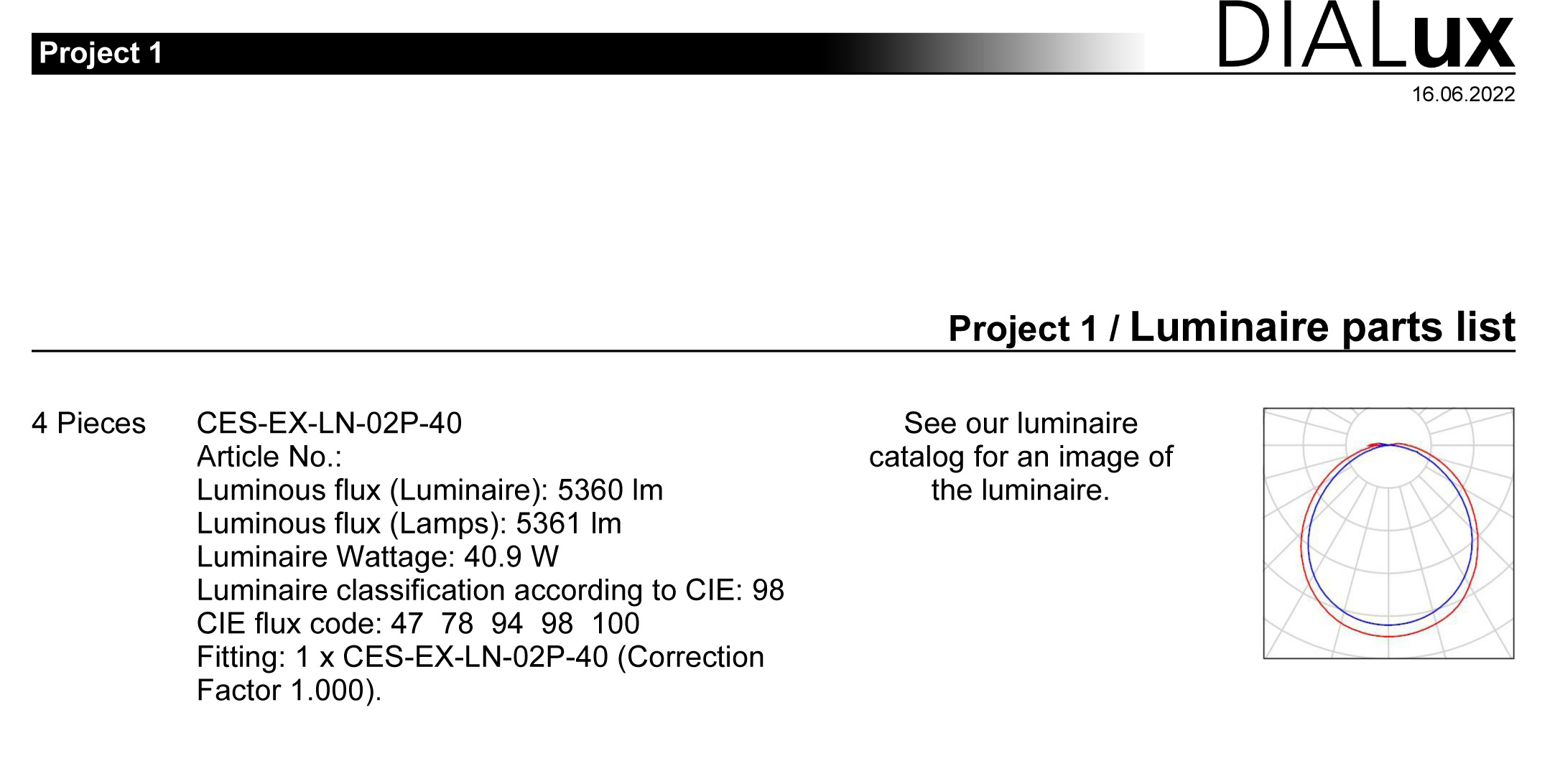
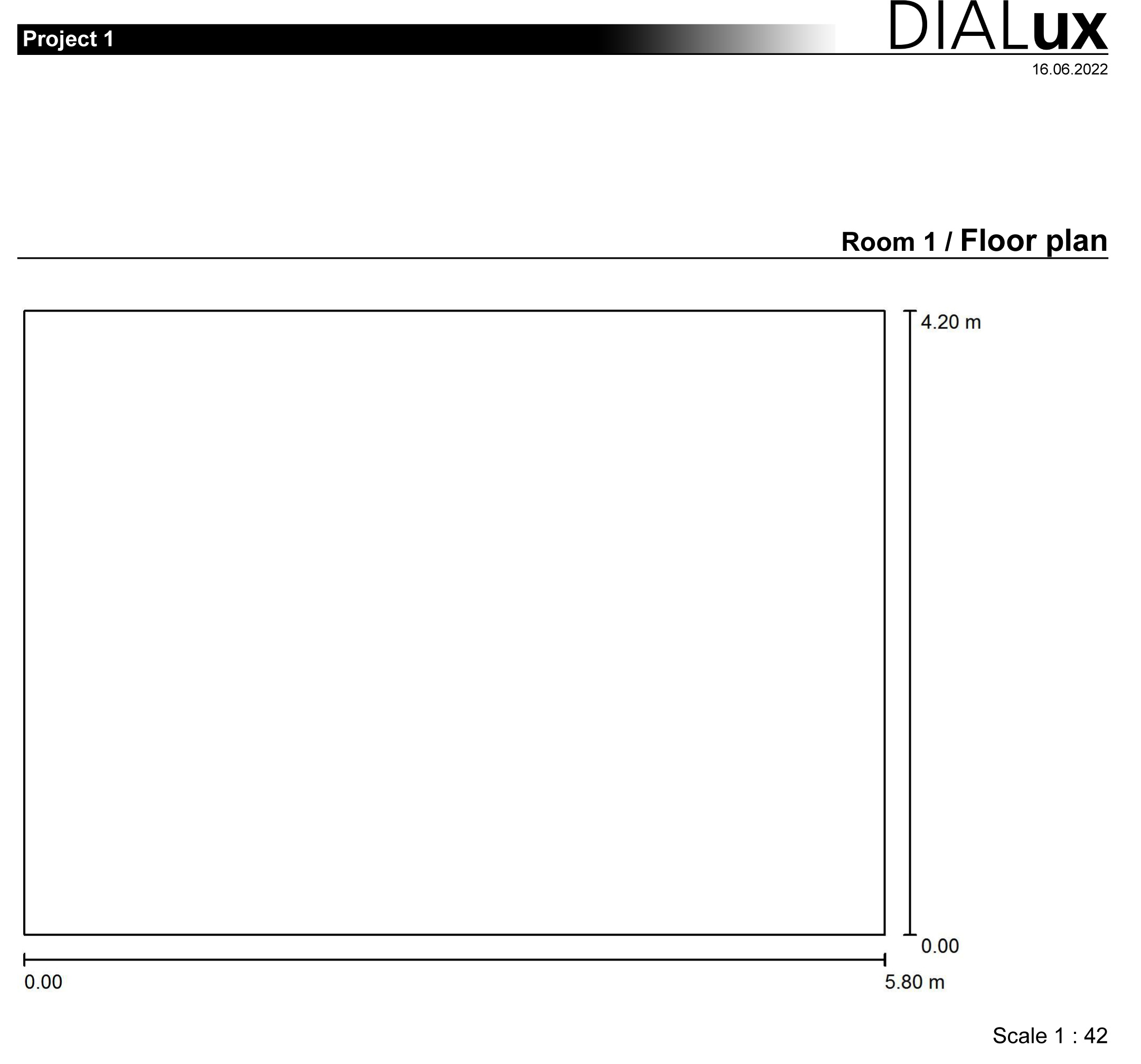
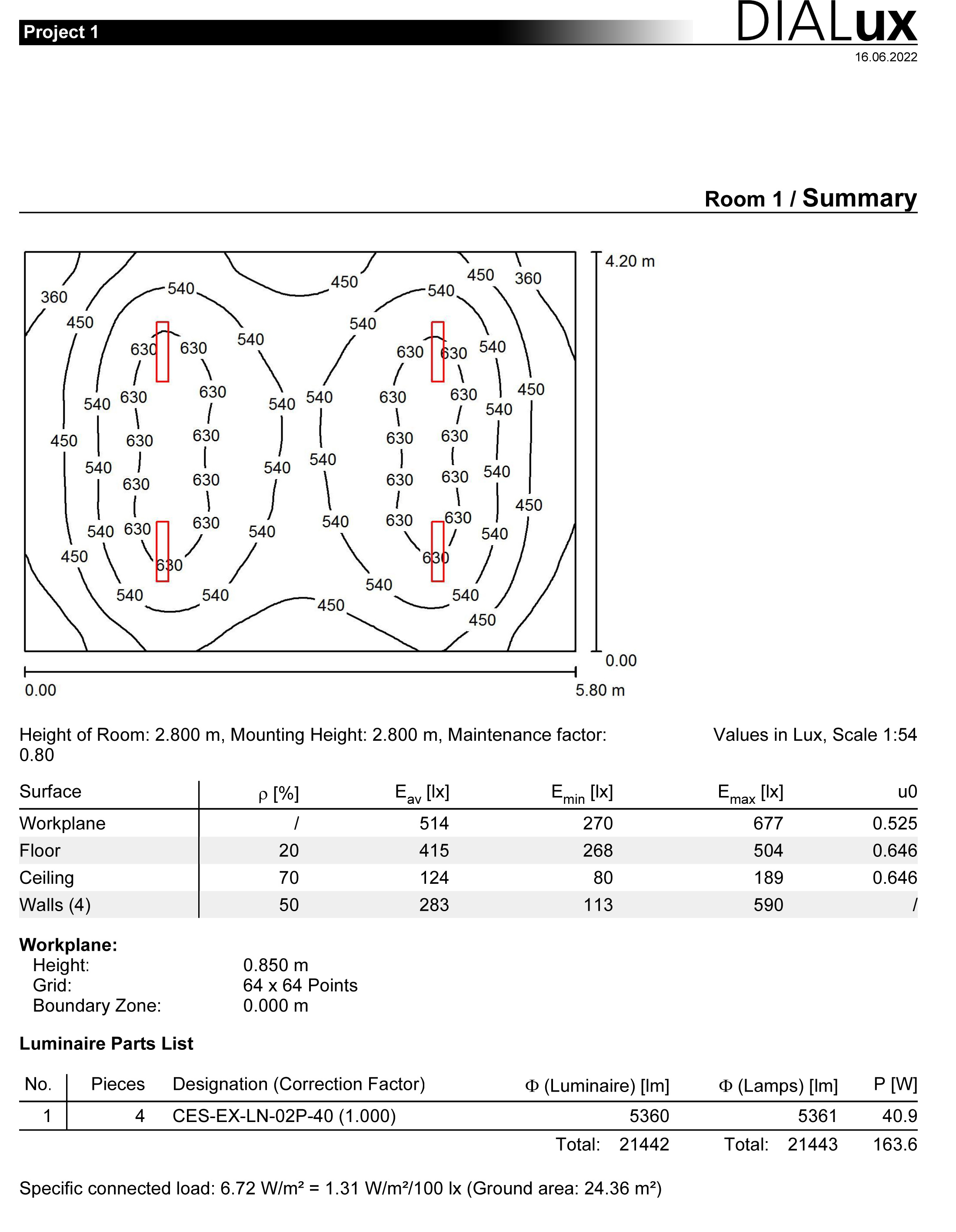
In addition, a customer in the UK made a request for their car paint booth project:
- The brightness requirements are very high, the illuminance must reach 750 LUX, and it must withstand the test.
- The requirements must be explosion-proof lamps, and can reach Zone 1, IIC level, with ATEX explosion-proof certification and inspection report
- Whether the light will be too dazzling, it is required to change the tempered glass of the lamp to anti-glare glass, so that people will not feel uncomfortable when looking at the light, and they will feel much more relaxed when working.
- It is required that there should be no chromatic aberration, and the wavelength is similar to that of sunlight, so that the sprayed product will not change color. He said that the painter first adjusted the color outdoors, and then used it to spray, so the color temperature of the lamps in the spray booth is generally around 5500K, which is white light.
No matter what kind of spray booth, we will provide a design that meets the lighting requirements according to the customer's application scenario.
If you have any needs, please feel free to contact us. We are happy to offer you a dialux design solution free of charge.
How to design and manufacture a good flameproof type explosion-proof lamp
The explosion-proof lamps of flameproof type is mainly in the product structure, with a certain explosion-proof joint surface or explosion-proof thread, through an integral explosion-proof shell, to withstand the explosion pressure of the explosive mixture that may be generated inside the lamp, And prevent the explosion to the surrounding explosive mixture to achieve explosion-proof purposes.
Flameproof Type Explosion Proof LED Light CES-EX-LN Series
“10mm-thick tempered glass + ADC12and 6063 aluminum housing for CES-EX-LN explosion proof led linear light is shock-resistant, anti-vibration, can withstand 7J impact, and is equipped with micro-light elements to reduce direct visual contact with the light source, prevent glare, and replace the old and prone to failure Fluorescent light fixtures.”
Part. 1 The explosion-proof principle of flameproof lamps
Flameproof explosion-proof lamps, which can be used with a power supply not exceeding 1000V include incandescent lamps, tungsten halogen lamps, fluorescent lamp (including compact fluorescent lamps), high-pressure mercury lamps, high-pressure sodium lamps, self-ballasted high-pressure mercury lamps and metal halide lamps, etc. . Its structural characteristics are first of all that it must have a device that can withstand the requirements of IEC 60079-1 "protected by a flameproof enclosure "d". This integral flameproof enclosure, including the lamp body parts and Equipped with this, there are two parts of transparent parts such as a solid lampshade. According to the shape of the light source and the distribution of the illuminants, common flameproof lamps can be generally classified into vertical lamps equipped with gas discharge light sources such as incandescent lamps and high-pressure mercury lamps, and horizontal lamps equipped with straight fluorescent bulbs. There are two basic types of lamps. Its common components are lamp body, transparent parts, sealing parts, lamp sockets, inner reflectors and outer lamp umbrellas. The judgment of a good flameproof lamp mainly depends on the reasonable structure of the lamp body and the matching flameproof joint surface, the transparent part that can withstand the impact test and the thermal shock test, and the rubber seal with strong anti-aging ability. The lamp body is fixed with the transparent part, and then equipped with a lamp holder with reliable electrical performance. Through the reasonably designed inner reflector and outer lamp umbrella, the luminous flux of the light source inside the lamp can be irradiated to the outside of the lamp through the transparent part to the maximum extent, and the danger of explosion is caused. Ideal lighting effect for places. How to organically combine these components and make a reasonable layout is the key to the design and development of flameproof and explosion-proof lamps at present and in the future.
Part.2 Basic requirements for flameproof enclosures of lamps
For flameproof lamps, the flameproof enclosure is the key component of this type of flameproof explosion-proof electrical equipment, so the flameproof enclosure must meet the general requirements and special requirements for flameproof performance.
- General requirements
- Explosion proof lamps are special lamps and must meet the general requirements of ordinary lamps.
- The shell shape of the lamp strives to be beautiful, compact and reliable, light and good in craftsmanship.
- Sufficient volume is required to place electrical components such as lamp sockets, bulbs, reflectors, binding posts, and lighting accessories. At the same time, the rationality of the layout should be considered to facilitate installation, replacement of light sources, and other use and maintenance.
- There must be a transparent part with a certain surface area, so that the luminous flux of the light source inside the lamp can be effectively projected through the reflective part.
- To comprehensively consider measures such as heat dissipation, dustproof, waterproof and anti-corrosion, and give sufficient guarantee on the structure.
- In the appropriate position, the internal and external grounding shall be arranged reasonably, and there shall be corresponding permanent grounding signs.
- Special requirements
The national explosion-proof standard of flameproof enclosure requires that it can withstand the explosion pressure of the internal explosive gas mixture and prevent the internal explosion flame from spreading to the explosive mixture around the enclosure; to meet this performance, the following special requirements must be specifically considered:
- Anti-explosion performance. The shell of the lamp is required to have sufficient strength and rigidity to withstand the explosion pressure that may be caused by the inner cavity of the lamp. Therefore, appropriate materials and wall thicknesses should be selected to form a perfect three-dimensional geometry distribution. This cavity structure should be both beautiful and generous. Uneven stress caused by excessive shape changes should be avoided as much as possible in order to ensure that the dynamic strength test specified in IEC 60079-1 can finally be passed.
- Flameproof function. When designing the flameproof enclosure of the lamp, it is necessary to select the appropriate flameproof joint surface structural parameters, the way of introducing the device, the sealing structure of the transparent part and the lamp body part, and the roughness of the flameproof joint surface in strict accordance with the provisions of IEC 60079-1. In order to effectively prevent the internal explosion flame from propagating to the explosive mixture around the enclosure, it finally passes the flameproof performance test specified in IEC 60079-1.
- The flameproof shell of lamps is mostly composed of 2 or more connected cavities, which is prone to pressure overlap. Generally speaking, this will cause the explosion pressure to rise abnormally and sharply and exceed the expected maximum pressure. To this end, the area of the communication hole should be increased as much as possible, so that the shape of the inner casing can eliminate the pressure overlapping phenomenon. If the phenomenon of pressure overlap cannot be eliminated in practice, explosion-proof measures should be taken between the chambers to eliminate pressure overlap.
- For IIC flameproof lamps, IEC 60079-1 strictly stipulates that the plane flameproof joint surface whose flameproof gap tends to increase during explosion should not be used. The structure of the thread is used, so that the lamp cavity can be opened smoothly when the lamp is replaced or repaired.
Flameproof Proof LED Hand Lamp CES-EX-SC Series (ATEX / IECEx Zone 1)
“Durable, corrosion-resistant, and has undergone extreme hydraulic and heavy pressure tests and can withstand 7J impact. It has the characteristics of small size, light weight, portable etc. No hot when operate at the highest temperature, internal locking can prevent the cable from pulling out. can be used in hazardous areas Zone 1&21, Zone 2&22.”
Part.3 Design, manufacture and installation of transparent parts of flameproof lamps
As a flame-proof type explosion-proof lamp, there must be a certain light-transmitting part. At present, our country is basically made of glass material and is fixedly installed on the cavity of the explosion-proof lamp. Therefore, these glass transparent parts of flameproof lamps must not only meet the impact test and thermal shock test requirements of the transparent parts in the general requirements of IEC 60079-0, but more importantly, they must withstand the requirements specified in IEC 60079-1. Dynamic Strength Test. This requires that these transparent glass parts need to have sufficient strength, that is, they must have sufficient thickness and a certain geometric distribution, and undergo processing such as tempering. When designing transparent glass parts, we must pay attention to the reasonable selection of glass thickness and the determination of shape. Everything is premised on avoiding uneven stress in the finished product of the transparent parts, and at the same time, it is necessary to ensure that there is no sudden change in thickness. The main advantages of glass are that it can maintain its physical and light transmission properties under high temperature, ultraviolet radiation and long-term humid conditions, the surface is resistant to scratches by hard particles, and it is allowed to be immersed in aqueous or organic solvents without causing stress. cracks or corrosion. The main disadvantage of glass is its brittleness and low tensile strength. In order to make up for these shortcomings, when designing the assembly structure of the glass transparent part and the lamp body, a gasket is usually inserted between the glass transparent part and the metal parts of the lamp housing to prevent point contact with the metal parts of the housing and damage the glass transparent part. In order to prevent the impact of solid foreign objects from breaking the glass transparent parts, the commonly used method is to add a grille to protect it. If no grille grille is installed, the glass transparent parts must pass the high energy impact test specified in IEC 60079-0.
Generally, when the transparent parts of flameproof lamps adopt a sealed structure, the thickness of the gasket shall not be less than 2.0mm, and the width of the embedded part of the gasket between the metal shell and the glass transparent part shall not be less than 10.0mm. At the same time, glass transparent parts should generally be installed in the inner cavity, because when there is pressure inside, the elastic gasket tends to be compressed, which will strengthen the sealing performance. The material of the elastic gasket is generally made of nitrile rubber; when the power of the lamp is large, asbestos rubber sheet or silicone rubber, fluorine rubber and other materials that are self-extinguishing from fire can be used. It must also be noted that when installing the glass transparent parts, measures should be taken to ensure that the perimeter of the lampshade, glass tube and transparent plate should be compressed structurally, and the force should be uniform to avoid causing dangerous mechanical stress inside the transparent parts. For the glass transparent parts of explosion-proof lamps, it can also be sealed and fixed by direct glue sealing with the shell lamp body. This structure has higher requirements on the sealing material, and silicone rubber is suitable. The fixing of the transparent part of the luminaire and the housing part must be ensured in structure that when the light source is replaced, the transparent part and the sealing part shall not fall off the housing part.
Part.4 Selection of the introduction method of explosion-proof lamps
The introduction method of flameproof lamps is clearly stipulated in IEC 60079-1, that is, indirect introduction methods are required for lamps, but direct introduction methods can be adopted for Class I fluorescent lamps with flameproof lamp sockets and cold-start fluorescent lamps. This regulation of the introduction method is mainly due to the fact that it is impossible to completely avoid the generation of sparks, arcs or dangerous temperatures inside the explosion-proof lamps during normal operation. The indirect introduction method is to electrically connect the lamp with cables or wires through the junction box or plug, and the lamp is divided into two independent cavities in structure, the main cavity of the lamp and the wiring cavity, that is, the two-chamber explosion-proof cavity. Structure, so that the reliability of explosion-proof safety is fully guaranteed.
Part.5 Maintenance of explosion-proof lamps
Explosion-proof lamps are allowed to be repaired in principle, and the specific requirements are:
- Lamp Repair Requirements
Detachable parts of lamps and lanterns are allowed to be replaced with accessories. The accessories must be the same as the original and must meet the relevant regulations of IEC 60079-1, IEC 60079-2 and IEC 60079-7 respectively.
The replacement here is to replace the maintenance activities with accessories. Generally, non-professionals are required not to open or disassemble the flameproof lamps. The usual maintenance is mainly to replace the consumable electrical components such as the light source and the starter of the fluorescent lamp and the trigger of the gas discharge lamp. , After the installation and disassembly of the lamp, pay attention to whether the gasket between the transparent part of the lamp and the lamp body is restored to the original compressed state. If the sealing gasket is damaged, it must be replaced in time to ensure the reliability of explosion-proof performance.
- Replacement of lamp sockets
The lamp holder can be replaced as a whole. The explosion-proof lamp holder used for replacement must have a certificate or document approved by the explosion-proof inspection unit. The lamp holder accessories must be in good contact and have the heat resistance of the original.
The lamp holder is allowed to be replaced as a whole, mainly because the lamp holder is a complete part. The assembly of the lamp holder has many mutually restricting effects. If the parts are replaced, it will often affect the overall electrical performance of the lamp holder. The electrical conductivity and heat resistance of the socket accessories are very important. Random replacement will definitely reduce the overall performance of the lamp socket. Therefore, the requirements for the lamp socket accessories are relatively high, which is completely to avoid sparks inside the lamp. , The arc angle is considered.
- Ballast replacement
The ballast of explosion-proof lamps can be replaced with accessories of the same model and capacity. When changing the ballast mode, it must be approved by the explosion-proof inspection unit.
The technical performance of different types of ballasts is not exactly the same. When replacing different types of ballasts, it may cause changes in the temperature rise, insulation performance, and working performance of explosion-proof lamps. In explosion-proof lamps, this change It will definitely affect the explosion-proof level, so it is stipulated that only accessories of the same model and capacity are allowed to be replaced. When changing the ballast method, the temperature rise of the entire ballast component will change more, so the temperature rise and other tests must be re-tested. Determine the new explosion-proof level, and this kind of test identification can only be recognized after passing the test of the explosion-proof inspection unit.
If
What is the difference between Chinese GB3836 and international IEC explosion-proof certification standards?
According to the Standardization Law of the People's Republic of China, all explosion-proof standards are mandatory standards and must be enforced. Explosion-proof products (including imports) used in China must be certified by the state-designated explosion-proof inspection agency. Explosion-proof inspection and certification agencies, in accordance with the Chinese national standard GB3836 series, review and test the explosion-proof performance of explosion-proof motors, explosion-proof electrics, explosion-proof lights, explosion-proof instruments, explosion-proof communication equipment, explosion-proof transportation vehicles and explosion-proof mechanical equipment, and issue explosion-proof certificates. In addition to the GB3836 standard, China's coal safety certification also adopts China's unique industry standards for mining products.
China's explosion-proof standards are basically formulated according to the IEC standards of the International Electrotechnical Commission.
The relevant parameters of the same version of the national standard and the European standard are basically the same, but due to the time lag, the relevant parameters of the national standard are different from the European standard. In the 2004 and 2007 editions of the IEC standard, IIA and IIB have implemented the same parameter requirements.
However, the requirements of China's explosion-proof standards are basically the same as those of IEC. Some of China's GB3836 standards (gas) and GB12476 standards (dust) directly adopt IECEx explosion-proof standards.
China Explosion Proof Certification Standards for Explosive Gas Atmospheres:
- GB3836.1-2010-Explosive Atmospheres Part 1: General Requirements for Equipment
- GB3836.2-2010-Explosive Atmospheres Part 2: Equipment protected by flameproof enclosure "d"
- GB3836.3-2010-Explosive Atmospheres Part 3: Equipment protected by increased safety type "e"
- GB3836.4-2010-Explosive Atmospheres Part 4: Equipment protected by intrinsically safe "i"
- GB/T3836.5-2017 Explosive Atmospheres Part 5 Equipment protected by positive pressure enclosure p
- GB/T 3836.6-2017 Electrical Equipment for Explosive Gas Environments - Part 6: Oil-immersed "o"
- GB/T 3836.7-2017 Electrical Equipment for Explosive Gas Environments - Part 7: Sand-filled "q"
- GB3836.8-2014-Explosive Atmospheres-Part 8: Equipment protected by "n-type"
- GB3836.9-2014-Explosive Atmospheres Part 9: Equipment protected by encapsulation type "m"
China's explosion-proof certification standards for combustible dust environments:
- GB 12476.1-2013 Electrical Equipment for Combustible Dust Environment - Part 1: General Requirements
- GB 12476.2-2010 Electrical Equipment for Combustible Dust Environment - Part 2: Model Selection and Installation
- GB 12476.3-2007 Electrical equipment for combustible dust environments - Part 3: Classification of places where combustible dust exists or may exist
- GB 12476.4-2010 Electrical Equipment for Combustible Dust Environment - Part 4: Intrinsically Safe "iD"
- GB 12476.5-2013 Electrical Equipment for Combustible Dust Environment - Part 5: Shell Protection Type "tD"
- GB 12476.6-2010 Electrical Equipment for Combustible Dust Environment - Part 6: Encapsulation Protection Type "mD"
- GB 12476.7-2010 Electrical equipment for combustible dust environments - Part 7: Positive pressure protection type "pD"
International IEC explosion-proof certification standards:
- IEC 60079-0 Explosive Atmospheres Part 0: Equipment General Requirements
- IEC 60079-1 Explosive Atmospheres Part 1: Equipment protected by flameproof enclosure "d"
- IEC 60079-2 Explosive Atmospheres Part 2: Equipment protected by positive pressure enclosure type "p"
- IEC 60079-5 Explosive Atmospheres Part 5: Equipment protected by sand-filled mold "q"
- IEC 60079-6 Explosive Atmospheres Part 6: Equipment protected by oil-immersed type "o"
- IEC 60079-7 Explosive Atmospheres Part 7: Equipment protected by increased safety type "e"
- IEC 60079-11 Explosive Atmospheres Part 11: Equipment protected by intrinsically safe type "i"
- IEC 60079-15 Explosive Atmospheres Part 15: Equipment protected by non-sparking type "n"
- IEC 60079-18 Explosive Atmospheres Part 18: Equipment protected by encapsulation type "m"
- IEC 61241 series standard electrical equipment for combustible dust environment
- ISO/IEC80079-34 Explosive Atmospheres Part 34: Application of Quality Assurance System for Equipment Manufacturers.
If you are looking for the IECEx or ATEX Certifed Zone 1 Zone 21, Zone 2 Zone 22 Explosion Proof LED Light, please contact us by email: This email address is being protected from spambots. You need JavaScript enabled to view it. / This email address is being protected from spambots. You need JavaScript enabled to view it.
Influence of corrosive environment on explosion-proof light and electrical equipment
Tab: explosion proof electrical equipment, anti-corrosive lighting, marine lighting, corrosion resistant Lighting, influence of corrosive environment
Overview
The manufacture of any electrical equipment is inseparable from the materials and the use of any electrical equipment is also inseparable from the environment. Under the action of the surrounding environment, the performance of materials will decline, the state will change, and it will be damaged and deteriorated. This is corrosion. The corrosion behavior of materials is closely related to environmental conditions. Where there is a considerable concentration of chemically corrosive gases or vapors, especially when condensation occurs due to moisture, various forms of corrosion are provided for the occurrence and development of environmental conditions to accelerate materials (especially Corrosion of metal materials) leads to performance degradation or early failure of electrical equipment or components.
Part 1. Types of corrosion
In terms of corrosion, according to the corrosive environment, it can be divided into atmospheric corrosion, water corrosion, soil corrosion and chemical medium corrosion.
In general, atmospheric corrosion can also be classified into three categories: atmospheric industrial atmosphere, marine atmosphere, and rural atmosphere; the main influencing factors are humidity, industrial pollution, and salt content.
Water corrosion is mostly water that exists in nature, such as seawater, river water, rainwater, groundwater, etc. Most of these waters are near-neutral media, and the depolarizers in the corrosion process are mainly dissolved oxygen, some polluted water. There may be hydrogen depolarization.
Soil corrosion is generally electrochemical corrosion, and its main influencing factors are moisture, pH value, salt content, oxygen content, water permeability and air permeability, etc., as well as stray current and bacterial activity. Generally, soil corrosion resistivity is commonly used. As an indicator of corrosiveness, the smaller the resistivity, the greater the corrosiveness.
Chemical medium corrosion includes acid, alkali, salt, oxidant, non-electrolyte and melt and other corrosive media. Due to the wide variety and complex conditions, this type of corrosion has become the most complex and difficult to control corrosion problem.
Here, it is mainly aimed at different types (mainly related to flameproof type, increased safety type), different flameproof structures (plane type, stop type, cylindrical type, threaded type), different materials (stainless steel, carbon steel, aluminum, copper And plastic, rubber, coating, etc.) explosion-proof electrical products in the marine salt spray and sulfur dioxide corrosion environment artificial simulation accelerated test to obtain the material corrosion resistance and corrosion environment on the characteristics of explosion-proof structure damage and the impact on electrical explosion-proof safety performance .
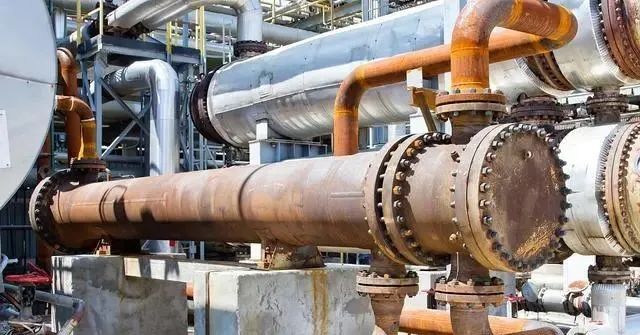
Part 2 Analysis of material corrosion characteristics
In order to ensure the reliable and long-term operation of explosion-proof electrical equipment, it is very important to closely combine the work of reasonable material selection, correct design, careful manufacture and good maintenance. Reasonable selection of materials is the first and foremost part, and environmental factors must be considered when selecting materials. We know that no material is omnipotent, and their applications are conditional. The so-called corrosion resistance is also relative, so we must look at the performance of each material in two. Material selection should be based on specific analysis of the corrosive environment. In order to facilitate the analysis, we selected the most representative (marine atmosphere) salt spray environment and (industrial atmosphere) sulfur dioxide corrosion environment as the simulated environmental conditions for material corrosion characteristics analysis, and analyzed its corrosion characteristics through material corrosion tests. Influence of explosion-proof performance of equipment.
The materials used in explosion-proof electrical equipment usually involve two categories, namely metal materials and non-metal materials. Commonly used metal materials include carbon steel and cast iron, stainless steel, aluminum and aluminum alloys, copper and copper alloys, etc.; non-metallic materials (only organic materials are considered here) There are plastic, rubber, glass fiber reinforced plastic, coating, etc. The corrosion mechanisms of metallic materials and non-metallic materials are different, and the corrosion characterization is also different. The corrosion of metal materials is generally electrochemical corrosion and is easily eroded by chemically corrosive media such as acids, alkalis, and salts; the corrosion of non-metallic materials is purely chemical or physical. ) and radiation to cause material swelling, degradation, deterioration, aging and other damage. The common corrosion forms of metallic materials are mostly manifested by surface features such as uniform corrosion, galvanic corrosion, crevice corrosion and pitting corrosion; non-metallic materials are corroded by changes in physical and mechanical properties (such as strength reduction, softening or hardening, etc.) or appearance. Damage (such as surface blistering, roughening or discoloration, etc.). Understanding the corrosion characteristics and corrosion resistance of materials under different environmental conditions can truly make the best use of materials.
Material _1: Stainless steel
Three grades of stainless steel, 321, 302 and 316L, were selected for the corrosion test. Although their corrosion in the humid SO2 and salt spray environment is electrochemical corrosion, the corrosion form in the humid SO2 environment is mainly uniform corrosion, while The form of corrosion in the salt spray environment is mainly localized corrosion. For example, the explosion-proof junction box made of 321 stainless steel has uniform corrosion on the surface of the sample after the SO2 corrosion test, but basically no corrosion on the surface of the sample after the salt spray test. Corrosion patterns in corrosive media are different.
Influence of SO2 corrosive environment on stainless steel
Different grades of stainless steel have different corrosion resistance in the same environment. Comparing 316L, 321 and 302 grades of stainless steel from the surface corrosion of the samples, exposed to SO2 gas corrosion environment, the corrosion resistance of 316L is obviously better than that of 321 and 302, while the surfaces of 321 and 302 samples show obvious corrosion. This means that they are not resistant to moisture SO2 corrosion.
The same grade of stainless steel has different corrosion resistance due to different protective conditions. For example, the shell of the explosion-proof anti-corrosion lamp with the grade of 321 has different corrosion conditions on the inner and outer surfaces due to the direct exposure and the protection conditions of the rubber sealing ring. After the corrosion test, the inner surface of the lamp shell is bright as new, indicating that The rubber sealing ring between the lamp body and the lampshade effectively blocks the immersion of SO2 corrosive gas, while the directly exposed outer surface of the lamp has rust in pieces.
Under the same environmental conditions, the same grade of stainless steel has different corrosion resistance due to different surface conditions. 316L is a stainless steel material with excellent corrosion resistance, but for example, the explosion-proof control button with the same grade of 316L and the F027 sample have large corrosion differences due to different surface conditions. The surface of the explosion-proof control button sample has a silver-white coating. The coating is thin and the surface state of the sample is not uniform due to the existence of local peeling defects, thereby promoting the occurrence and development of corrosion. Stainless steel generally has good corrosion resistance, and its surface is not suitable for coating when used as a structural material.
Influence of salt spray corrosion environment on stainless steel
Stainless steel is originally a material with good corrosion resistance, but in the salt spray environment, the passivation film on the surface of the stainless steel tends to be destroyed due to the presence of a large amount of Cl-, and the destroyed passivation film in the salt spray environment The ability to repair is reduced, which is the root cause of localized corrosion of stainless steel in the salt spray environment. The common local corrosion forms of stainless steel in salt spray environment include galvanic corrosion, crevice corrosion and pitting corrosion.
In the salt spray corrosion environment, the surface of the stainless steel sample basically did not undergo large-scale uniform corrosion, but the corrosion rust formed along the bolts was clearly visible, and the corrosion of all fastening bolts, washers and external grounding was relatively serious. Differences between the material of the bolts, washers, and external grounding and the material of the sample. In a corrosive environment, the contact of dissimilar metals with different potentials will generate a potential difference to form a galvanic couple, thereby accelerating the corrosion of the negative potential metal (anode), that is, galvanic corrosion. Therefore, the fasteners and grounding of the stainless steel shell should be made of the same material to avoid the occurrence of galvanic corrosion. In the design of explosion-proof electrical structure, the contact of dissimilar metals should be avoided as much as possible to cause galvanic corrosion. If it must be used, insulating pads (such as rubber and plastic) should be used to separate dissimilar metals. In addition, for explosion-proof electrical equipment made of stainless steel, the gap between the nameplate and the surface of the shell and the gap between the plane explosion-proof joints create conditions for crevice corrosion. Generally, crevice corrosion is most likely to occur in environments containing Cl-. The oxygen-deficient area is in an occluded state. With the occurrence and development of corrosion, the Cl- concentration in the crack increases, the pH value decreases, and the corrosion is accelerated. Although the crevice is the main design defect that causes corrosion, the crevice between the flameproof joint surfaces is unavoidable in the design, and grease with corrosion inhibitor can be applied to prevent crevice corrosion.
Both carbon steel and cast iron are iron-carbon alloys, which are inexpensive and have good mechanical and technological properties, especially carbon steel, which is widely used in structural materials for explosion-proof electrical products. In terms of corrosion resistance, its chemical stability is low. In practical applications, corrosion-resistant metal coatings or anti-corrosion measures such as paint protection are used to improve its corrosion resistance. The corrosion test is made of Q235A carbon steel.
Q235A is ordinary carbon steel, and its surface should be coated with a protective coating when used in a corrosive environment. After the SO2 corrosion test and the salt spray corrosion test, the surface coating of the sample is basically intact, but the surface corrosion of the nameplate, fastening bolts and washers is not well-coated or not protected. The plane or port-type flameproof joint of flameproof explosion-proof electrical equipment is bounded by the "O-type" rubber sealing ring. The outer part is corroded, and the inner part is not corroded. In addition, the flameproof joint after salt spray corrosion The surface corrosion is relatively light, while the corrosion of the flameproof joint surface after SO2 corrosion is more serious, which shows that the Q235A carbon steel has better resistance to salt spray corrosion than SO2 corrosion resistance.
The industrial application of aluminum alloy is second only to steel materials, and it is one of the most commonly used structural materials for the manufacture of explosion-proof electrical equipment. This is not only because of its light weight and low price, but also because of its surface The alumina protective film becomes a good protective barrier layer. The standard potential of aluminum is very negative, and it is a thermodynamically active metal. If it is used in a chemically corrosive environment, it is definitely not corrosion-resistant. Therefore, when using aluminum explosion-proof electrical equipment in a chemically corrosive environment, the surface must be designed with an anti-corrosion layer. For the corrosion test, aluminum materials with grades ZL102 and YL104 were selected.
The corrosion resistance of aluminum depends to a large extent on the surrounding environment and the stability of the surface oxide film in the medium. Moist SO2 can accelerate the corrosion of aluminum, but compared with Fe and Cu under the same conditions, aluminum is still corrosion resistant. The corrosion resistance of aluminum electrical equipment in SO2 corrosive environment mainly depends on the properties of its surface protective coating. After the SO2 gas corrosion test, the surface coating of the sample did not corrode significantly, and the underlying metal aluminum did not corrode, indicating that the coating Played the due protective effect.
In the marine salt spray environment, aluminum is not resistant to corrosion in the salt spray environment containing Cl- because Cl- can destroy its passivation film and is prone to pitting corrosion. The radius of Cl- is small, and its ability to penetrate and diffuse into the interior through the micropores of the coating is relatively strong. At the same time, Cl- is extremely corrosive to metal aluminum. Therefore, after corroding the surface coating, it continues to corrode the base metal. The product is loose and expands in volume, which further promotes cracking, peeling and peeling of the surface coating. After salt spray test, almost all aluminum explosion-proof electrical equipment not only has quality defects such as serious bubbling, warping, peeling, and falling off on the outer surface coating/plating, but also the bottom metal aluminum is also severely corroded. The damage starts from the corners, which fully illustrates the corner effect of the coating, that is, the corners are the weakest and most prone to quality defects of the coating.
Metal aluminum is very sensitive to chloride ions. After corrosion, a layer of white powdery corrosion products is formed on the surface, which has a great impact on the threaded structure. The threads of the aluminum alloys cannot be opened due to severe corrosion, and the fasteners (such as bolts, nuts) and threaded parts of all aluminum samples in the salt spray environment are blocked by corrosion products, which brings great inconvenience to the disassembly of all threaded structures. Due to the presence of a large amount of Cl- in the salt spray environment, Al is severely corroded, so aluminum explosion-proof electrical equipment is not suitable for use in the salt spray environment.
Under atmospheric conditions, copper is relatively stable; in humid SO2, the corrosion of copper is intensified. At this time, a film of CuSO4 3Cu(OH)2 alkaline copper sulfate is formed on the surface of copper. This film has no Protective effect; in the marine atmosphere, in addition to the formation of alkaline copper sulfate CuSO4 3Cu(OH)2 on the surface of copper, there is also alkaline copper chloride CuCl2 3Cu(OH)2. Widely used in practice are copper alloys—brass, bronze, and especially bronze, often used as corrosion-resistant structural materials. For the corrosion test, ordinary brass H59 was selected, and the test showed that it is not resistant to corrosion by salt spray and humid SO2 medium. The material of the explosion-proof junction box is H59. After the corrosion test, the surface coating of the junction box does not change significantly, but the surface of the copper nameplate is also corroded even after the coating treatment. In the salt spray environment, it corrodes and turns white; the junction box flameproof joint surface shows obvious corrosion whether in the SO2 environment or in the salt spray environment, and the corrosion occurs outside the "O-type" rubber sealing ring. The plane part, while the cylindrical part inside the "O-type" rubber sealing ring has no corrosion, which means that the "O-type" rubber sealing ring blocks the channel for the inward diffusion of corrosive gas and plays a protective role. In addition, the surface of the copper sealing stuffing box of the explosion-proof junction box has not been subjected to any protective treatment, and is directly exposed to the corrosive environment. In the SO2 environment, the corrosion is black, while in the salt spray environment, patina corrosion products appear. From the above analysis, it is not difficult to see that copper and copper alloys should not be directly exposed to corrosive environments, that is to say, copper explosion-proof electrical appliances should be surface protected when used in corrosive environments, and their corrosion resistance depends on the properties of the surface coating and paint quality.
Plastic is a type of polymer material that is mainly composed of resin, and can be plasticized and formed during processing with appropriate additives. Therefore, it can also be said that plastic is a polymer product dominated by resin. Plastic materials are widely used in the manufacture of explosion-proof electrical equipment due to their excellent processing properties, corrosion resistance and electrical insulation properties. For electrical insulating materials, their dielectric properties, heat resistance and flame retardancy must exceed the specified index by an appropriate range to increase their safety factor to prevent local heating or breakdown caused by excessive voltage and current, resulting in fire, explosion accident. On the other hand, plastics have good electrical insulation properties and are prone to electrostatic accumulation. Measures should be taken to ensure their safety when used in flammable and explosive environments.
The test selected several plastic materials commonly used in explosion-proof electrical equipment, such as polyhexamethylene adipamide (polyamide-66), polyvinyl chloride plastic (PVC), acrylonitrile-butadiene-styrene copolymer (ABS engineering Plastics), polycarbonate plastics (PC), unsaturated polyester sheet molding compounds (SMC), unsaturated polyester bulk molding compounds (DMC), etc., which show better performance in SO2 and salt spray corrosion environments Therefore, under the premise of meeting the technical requirements of explosion-proof, plastic materials can be used as structural materials for explosion-proof electrical equipment in corrosive environments.
After the corrosion test, the plastic shell of the sample is basically free of corrosion, but all the metal parts (fasteners, nameplates, etc.) in the sample show obvious corrosion; Corrosion of metal parts) indicates that corrosive media has entered the interior, so the corrosion of internal components depends on the protection performance of the sample. In addition, some samples of unsaturated polyester molding compounds (SMC, DMC) have discoloration and roughening on the surface after SO2 corrosion test, but there is no change after salt spray corrosion test, which shows that SMC and DMC materials are resistant to salt spray. The performance is better than that of SO2 corrosion resistance.
Although plastic materials have many advantages and good comprehensive performance, they often cannot or should not be used under certain conditions. Plastics cannot be used when the material strength is particularly high. The use temperature range of plastic materials is narrow, and plastics should not be used when the use temperature is too high or too low. This is because plastic is a viscoelastic material that is extremely sensitive to temperature changes. Generally, the mechanical properties, electrical properties and corrosion resistance of plastic materials decrease with the increase of temperature, and when the temperature is too low, the plastic material will become hard, brittle, easy to crack, and even lose its performance. In addition to ambient temperature, humidity and medium conditions, the selection of plastic materials should also consider environmental factors such as light, oxygen, and radiation. Under the environment of light, oxygen and radiation, plastic products will cause plastic degradation reaction (ie aging), resulting in the decline of the performance of plastic products, thus greatly shortening their service life. Therefore, explosion-proof electrical equipment made of plastic materials should not be exposed to outdoor use for a long time.
The coating generally refers to the non-metallic coating (including organic coatings and inorganic coatings) covering the metal surface; and the coating refers to the metal covering such as electroplating, hot dip plating, and electroless plating on the metal surface. That is, the metal/alloy or coating with strong corrosion resistance is used to cover the metal with weak corrosion resistance to achieve the purpose of anti-corrosion. Coating and plating combine the excellent properties of both the protective layer and the protected layer, such as the corrosion resistance, wear resistance and oxidation resistance of the protective layer, and the strength and stiffness of the protected layer. Compared with the non-metallic protective layer, the metal protective layer has the advantages of high strength and good heat resistance, and the non-metallic protective layer has the advantages of convenient construction and good corrosion resistance. The coatings and coatings on the metal surface are generally porous films. Although they cannot completely isolate the metal from the corrosive medium, the existence of the coating and the coating can increase the diffusion resistance and solution resistance of the corrosive medium through the pores, so that the corrosion current can be reduced. down thereby slowing the corrosion of the underlying metal.
The coating and plating on the surface of explosion-proof electrical products is an important protection method used to isolate the base material and the surrounding environment. In the design of coating and coating, materials with good corrosion resistance should be selected according to environmental conditions. At the same time, the coating quality of coating and coating is also directly related to its corrosion resistance and service life. Only those well-coated and coated surfaces can play a role. Due to the protective effect, coatings and coatings with defects such as cracks, mechanical scratches, and local shedding not only have no protective effect, but also accelerate corrosion. In addition, the service life of the coating and plating layer is related to the strong and weak corrosiveness of the environmental medium in the installation site of explosion-proof electrical products. During the service life of explosion-proof electrical equipment, recoating protection can be planned according to the surrounding environmental medium conditions to prolong the explosion-proof electrical equipment. service life.
Rubber is a highly elastic material that can be deformed under the action of external force and can be restored after the external force is removed. Therefore, it is a main sealing structure material. The essence of the rubber seal is to seal the gap between the two contact surfaces by plugging the rubber, that is, the contact surface seal. Rubber is usually used as a seal in explosion-proof electrical equipment. If the seal is permanently deformed under the action of external force, the sealing effect is not good or the sealing performance is lost. Therefore, the permanent deformation of the seal material should be small, the elasticity should be high, the resilience should be strong, and it should have appropriate hardness; the rubber material has certain When the temperature is higher than the limit temperature, the elasticity will be lost due to aging; when the temperature is lower than the limit temperature, the high elastic deformation will be suppressed and the rigidity will be enhanced. Therefore, if the temperature exceeds the operating temperature range, the rubber seal will lose its sealing performance; in addition, it should be noted that Under the action of pressure, temperature and medium, the vulcanized rubber itself will age after a certain period of time, resulting in irreversible deformation and damage to the sealing performance. When it is lost, it should be replaced in time.
Natural rubber is easy to age under the action of oxygen, so natural rubber is rarely used as a seal, and synthetic rubber is usually used as a seal, such as nitrile rubber, neoprene, ethylene propylene rubber, butyl rubber, butadiene rubber, Silicone rubber and fluorine rubber, etc. Different types of rubber seals have different sealing properties. When selecting materials, various properties such as tensile strength, permanent deformation, hardness, temperature resistance, medium resistance, and permeability should be considered, and selected according to actual working conditions. , in order to improve the sealing effect. Nitrile rubber is a copolymer of butadiene and acrylonitrile. It has excellent oil resistance. It also has the mechanical strength and wear resistance required as a sealing material. It is widely used in various seals; neoprene is a kind of The polarity is second only to the self-reinforcing elastomer of nitrile rubber. It is the best kind of general-purpose rubber, and it is a flame-retardant rubber. Ethylene-propylene rubber is a copolymer of ethylene and propylene. Halo performance is very outstanding, and the price is cheap; Butyl rubber is made of isobutylene and isoprene copolymerization, the most prominent feature is low air permeability, is the best air tightness rubber, can be used for vacuum sealing; Rubber is a general-purpose synthetic rubber polymerized from butadiene as raw material. The glass transition temperature of high cis-butadiene rubber is as low as -105 °C, so it has good low temperature resistance and is an excellent material for making sealing products in low-cold areas. Good flexibility, especially suitable for sealing needs to withstand multiple deformations; silicone rubber has a wide operating temperature range (-100 ° C ~ +350 ° C), good air permeability, but its shortcomings are low strength and high price; fluorine rubber The biggest feature is high corrosion resistance, its high temperature resistance is comparable to that of silicone rubber, and it has excellent high vacuum resistance.
The corrosion test uses nitrile rubber. After the corrosion test of the sample, the surface of the sample has no corrosion characteristics such as delamination, brittle cracking, deformation and stickiness. The hardness change rate of the rubber sample before and after the test in the SO2 environment is 4.4%. The hardness change rate of the rubber samples before and after the test in the environment is 4.1%, which meets the requirements of relevant standards, indicating that the nitrile rubber has excellent corrosion resistance in SO2 and salt spray environments. Material corrosion test results show that non-metallic materials have better corrosion resistance than metal materials in chemically corrosive environments. As far as metal materials are concerned, Fe corrodes more seriously than Al in SO2 environment, while Al corrodes more seriously than Fe in salt spray environment; stainless steel corrodes more seriously in SO2 environment than in salt spray environment; copper and copper alloys corrode more in SO2 environment. Corrosion was evident in both the copper and the salt spray environment, the copper surface corroded and turned black in the SO2 environment, and patina appeared in the salt spray environment. The surface of ordinary metal materials (such as carbon steel, aluminum, copper, etc.) used in corrosive environments should be designed with protective coatings, and attention should also be paid to strengthening the sealing protection of the casing structure to avoid the intrusion of corrosive media.
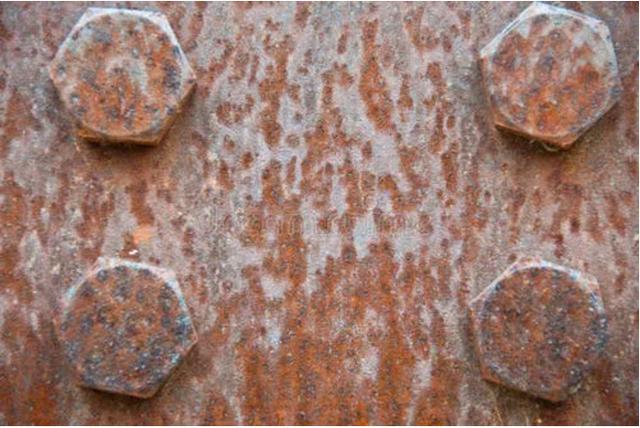
Part.3: Influence of Corrosion on Explosion-Proof Performance of Electrical Equipment
The effect of corrosion on flameproof jointsof explosion proof electrical equipment
The standard GB3836.2-2010 stipulates that "the average surface roughness Ra of the joint surface shall not exceed 6.3μm". After the corrosion test, the flameproof joint surface of some flameproof explosion-proof electrical equipment is corroded, and the average surface roughness far exceeds the standard value and cannot meet the explosion-proof requirements.
Tests show that among several different types of flameproof joints, the corrosion of the flat flameproof joint is the most serious, while the corrosion of the cylindrical, spigot and threaded flameproof joints is relatively light. The corrosion of explosion-proof joints is related to the ease with which corrosive gases come into contact with explosion-proof joints. From the structural point of view of the flameproof joint surface, the path for corrosive gas to enter the flameproof cavity through the plane and cylindrical joint surfaces is linear; the path through the port type is "L" shape; the path through the threaded type For the zigzag line, it is obvious that the corrosive medium is the easiest to pass through the flat and cylindrical joint surfaces, followed by the spigot type, and the threaded type is the most difficult. In addition, whether it is a plane type or a spigot type flameproof joint, the plane part outside the "O-type" rubber seal is severely corroded, while the part inside the "O-type" rubber seal has no corrosion. The test results show that, If an "O" ring is set on the flameproof joint surface, it can block the passage of the corrosive medium from diffusing into the flameproof cavity. Corrosive medium entering the cavity affects the performance and life of the internal electrical components.
The explosion-proof joint surface of explosion-proof explosion-proof electrical equipment is not allowed to be painted, only grease is allowed. Grease will lose its anti-corrosion effect when used in a corrosive environment for a long time. Therefore, explosion-proof electrical equipment should be regularly cleaned during its service life. The flameproof joint surface shall be oiled and maintained.
Influence of Corrosion on Strength of Explosion-Proof Electrical Enclosures
After the salt spray corrosion test, the surface coating of aluminum explosion-proof electrical equipment is severely peeled and peeled off. After the coating is peeled off, the salt spray further corrodes the underlying metal, which will lead to changes in the strength and mechanical properties of the shell over time. For example, after some aluminum electrical equipment is subjected to the salt spray test, and then the impact test specified in GB3836.1-2010 and the explosion test specified in GB3836.2-2010, the sample ruptures and does not meet the requirements of explosion-proof performance.
Effects of Corrosion on Explosion-Proof Electrical Fasteners
The strength of fasteners is particularly important for the explosion-proof performance of flameproof electrical equipment. Clause 11 of the standard GB3836.2-2010 (equivalent to IEC60079-1:2007) specifies that the minimum yield stress of fasteners is 240N/mm2. After the corrosion test, most fasteners are corroded to varying degrees, and the yield stress of the corroded fasteners must change, which is likely to fail to meet this requirement. Therefore, the material of the fasteners of explosion-proof electrical equipment used in corrosive environments must also be resistant to corrosion.
Influence on the internal wiring terminals of explosion-proof electrical equipment
GB3836.3-2010 stipulates that the temperature of electrical equipment components does not exceed the maximum surface temperature specified in GB3836.1-2010. Corrosion of the terminals will inevitably cause the contact resistance to increase, resulting in an increase in temperature, so that the terminals that originally meet the temperature group exceed the specified maximum surface temperature and fail to achieve the original explosion-proof performance. An effective way to prevent corrosion of internal terminals is to enhance the sealing performance of the protective structure of the housing to achieve IP54 or IP55 protection level.
The effect of corrosion on explosion-proof electrical nameplates
GB3836.3-2010 stipulates that the temperature of electrical equipment components does not exceed the maximum surface temperature specified in GB3836.1-2010. Corrosion of the terminals will inevitably cause the contact resistance to increase, resulting in an increase in temperature, so that the terminals that originally meet the temperature group exceed the specified maximum surface temperature and fail to achieve the original explosion-proof performance. An effective way to prevent corrosion of internal terminals is to enhance the sealing performance of the protective structure of the housing to achieve IP54 or IP55 protection level.
Part.4: Determination and detection methods of different anti-corrosion grades
Corrosive environmental conditions and their test standards
GB4796 is the classification of environmental parameters of electrical and electronic products and the grading standard of severity. GB4797 and GB4798 series of standards are the environmental conditions and application environmental conditions of electrical and electronic products respectively. Most of these standards are equivalent or modified to adopt the IEC60721 series of the International Electrotechnical Commission Standard; GB2423 series standards are environmental test series standards for electrical and electronic products in my country. Most of this series of standards are equivalent or modified to adopt IEC60068 series standards of the International Electrotechnical Commission. method; in addition, there are a series of JB standards that can be used with reference.
Test methods for different anti-corrosion grades
Explosion-proof electrical equipment is used under different environmental conditions such as chemical corrosion and will be affected by environmental corrosion. Therefore, on the basis of reasonable selection of materials, correct design, and careful manufacture, explosion-proof electrical products should pass relevant explosion-proof type tests and corresponding environmental tests according to the expected environmental conditions to verify their reliability scientifically, and based on the corrosion results obtained by artificial simulated environmental tests Trends and approximate results, scientifically guide the development, manufacture, selection and use of explosion-proof electrical products. The environmental tests involved in different anti-corrosion levels usually include damp heat test, chemical gas corrosion test and comprehensive test of different combinations of environmental factors.
The reliability of explosion-proof and light-corrosion-proof electrical products that are fixed in places without climate protection can usually be verified by damp heat test. Generally speaking, the corrosion rate increases as the relative humidity increases. The test method of the damp heat test can be carried out according to the provisions of GB/T2423.4. The severity level of the damp heat test is determined by the combination of high temperature (55°C or 40°C) and different test cycles, which can be appropriately selected according to the product use environment. Before the test, during the test and after the test, the samples should be visually inspected and performance tested according to the relevant requirements, so as to determine the environmental adaptability, electrical and mechanical properties of the explosion-proof and light-corrosion-proof electrical products that are used in non-climate protected places. changes.
Explosion-proof and medium-corrosion-proof electrical products that are used in non-climate protection places and places with climate protection should at least pass 2 cycles of sulfur dioxide gas corrosion test to verify their reliability; Strongly corrosive electrical products should at least pass a 10-cycle sulfur dioxide gas corrosion test to verify their reliability. The test method of the corrosion test can be carried out according to the provisions of GB2423.33. Before the test, during the test and after the test, the appearance inspection and performance test of the sample should be carried out according to the relevant requirements. If the appearance or function of the sample has been damaged due to corrosion during the test process , the test can be terminated, and it can be determined that the test sample is not suitable for chemical corrosion environment.
The reliability of explosion-proof electrical products used in the marine salt spray environment shall be verified through the corresponding salt spray test. The test method of the salt spray test can be carried out according to the provisions of GB/T2423.17 (Test Ka) or GB/T2423.18 (Test Kb). The test Ka is used to divide the severity level by the duration of continuous salt spray. This test method is suitable for assessing the ability of materials, protective layers and products to resist salt spray corrosion, but it should not be used as a general corrosion test method; test Kb is composed of two Or two or more different environmental stages are combined to form different severity levels, which can more effectively simulate the effect of natural salt spray environment. In addition to showing the corrosion effect of salt spray, it can also show the degree of deterioration of some non-metallic materials due to absorption of salt. , and can also be used as a general corrosion test method.
After the artificial simulated accelerated corrosion test, relevant tests on electrical performance should be carried out according to the technical requirements of the product. For example, in the electrical insulation performance test, it is required that the insulation resistance value between the outer casing of the electrical appliance and the conductive parts and between the conductive parts that are insulated from each other is not less than 2MΩ, and the dielectric properties meet the relevant regulations of the technical standard; After the test, the action and operation performance of the electrical appliance should be flexible and reliable, and the conductive/magnetic conductive elements, metal structural parts and fasteners on the outer casing should not show obvious corrosion (such as patina and rust); the paint layer on the surface of the casing should not appear loose, Obvious bubbling, peeling, peeling and bottom metal corrosion, etc.; plastic casings and plastic parts on the casing shall not be blistered, deformed or brittle; rubber parts shall not be corroded, delaminated, brittle, deformed and sticky, sealing rings and seals The hardness change value of the gasket shall not be greater than 20% of that before the test; the nameplate shall not corrode, lift or fall off, and the writing on the nameplate shall be clear; the flameproof surface of the flameproof electrical appliance shall not be corroded; the conductive parts and fasteners in the junction box shall not be corroded. There must be no visible corrosion.
Other Corrosion environment test
In addition to the above-mentioned different anti-corrosion grade judgment tests, there are many other environmental tests, such as temperature test (including low temperature test, high temperature test and temperature change test), low pressure test radiation test (mainly solar radiation and thermal radiation), mold test , Vibration test, tilt and swing test, impact test, noise test, electromagnetic compatibility test, etc., can be appropriately selected according to different places of use. It is important to point out that non-metallic materials are very sensitive to temperature and sunlight. Especially when the working environment is close to the limit temperature of the material, or when the product generates heat during use, or when there is a temperature change, the temperature test cannot be ignored. when it is used under sunlight (ultraviolet) irradiation conditions, the light test cannot be ignored.
Part.5: CESP Explosion proof lights and explosion proof electrical equipment for the corrosion environment
CESP anti-corrosion led lights and electronics equipment are made of Material _1: Stainless steel, Material_3: Aluminum and aluminum alloys and Material_6: "Coating, plating" used for anti-corrosion, then the the products throught electrophoresis technology, are coated with a non-metallic paint-like coating on the surface of the housing, which makes the appearance of the lamp flat, smooth, corrosion-resistant and impact-resistant. Then, apply multiple coats of marine anti-corrosion paint to enhance corrosion resistance. That can protect the lamps and equipment from long-term harsh salt water and atmospheric corrosion in the marine environment.
These items can applied to the marine environment, such as the Offshore Engineering, Offshore Facilities, Offshore Oil Platforms and seagoing vessel. In additional, it suitable for some chemical plants, sewage treatment plants are relatively harsh and corrosive environments.
Product Category of CESP Hazardous Area Lighting
Summary
Corrosion starts from the deterioration of material properties, which in turn affects the explosion-proof performance of electrical equipment. Environmental testing is an important means to ensure the quality of explosion-proof electrical products. It can discover potential quality hazards of explosion-proof electrical products and improve the safety and reliability of explosion-proof electrical products.
How to maintain explosion proof distribution panel and control station
Point. 1 Increase the emphasis on explosion proof distribution panel and control station
explosion proof distribution panel and control station are generally installed in places with harsh environments. They generally use cast iron casings. Chemical dust can chemically react with the cast iron casings, causing external corrosion or the formation of sticky attachments. Major damage, including mechanical jamming, aging plastic handlebars, corroded bolts, etc.
Explosion proof distribution panel and control station have to be updated in about 5 years. Some maintenance personnel are irresponsible, the explosion-proof end caps are not fixed well, and the terminal board is damaged at will, which will speed up its service life. Among them, the explosion proof distribution panel and control box start from the branch factory, strengthen their supervision and understand their importance. It cannot be regarded as just on-site equipment, which is maintained and managed by the chemical industry. explosion proof distribution panel are maintenance power supplies, not long-term or fixed equipment power supplies. Some maintenance power supplies have been occupied for a long time for water pumps, lighting or small equipment.
Point 2. Explosion proof distribution panel must be numbered uniformly
Many explosion proof distribution panel and control boxes have been uniformly numbered in the power distribution room, but the site number is confusing, and some signs have been dropped. , which greatly affects the maintenance efficiency. It is recommended that the low-voltage section use paint to mark the number at each explosion proof distribution panel and control panel to improve the identification and improve the maintenance efficiency.
Point 3. Adopt one-by-one contracting system
Number each explosion proof distribution panel and control station, and assign the operation section team to contract, and require the operation section on-duty to indicate the integrity of the explosion-proof control box in the work record when overhauling or using the explosion-proof distribution box and control box. And establish a registration book, fill in the registration book for each shift of the duty team, and report the missing bolts or broken end caps in time.
Point 4. Adopt the long-term maintenance system of sharding
The long-term maintenance system for explosion-proof distribution panel and control station is carried out by the team under the jurisdiction of the low-voltage section. Each explosion-proof distribution panel is registered and maintained, and the mechanical parts are maintained every month. Replacement, reinforcement of on-site signs and other related maintenance.
Point 5. Develop a long-term monitoring mechanism
A production period supervision mechanism is established for the explosion-proof control station, and one functional person in the operation section and the low-voltage section is assigned to check and register once a month, and the inspection content includes the identification.
1) Whether the bolts and end covers of explosion-proof distribution panel are in good condition;
2) Whether the explosion-proof distribution panel and control station are marked in the work record;
3) Whether the explosion-proof maintenance power supply is recorded in the contract registration form;
4) Whether the air switch and terminal board in the explosion-proof distribution panel and control station are in good condition; whether the wiring is firm, etc. And according to the relevant situation of the inspection, conduct a reasonable assessment of the operation section team and the low-voltage team.
Point 6. Other measures
1st. Improve the sleeve and hexagon socket tools to reduce the phenomenon that the explosion-proof control station cannot be removed or tightened due to tool defects.
2nd. Treat the bolts of the explosion-proof distribution box and control box, and use the welding and lengthening screws during installation to improve the maintenance efficiency of the operation section.
3rd. Try to use the same spare parts of the same type to reduce maintenance costs and improve maintenance efficiency.
Explosion-proof cable gland (single seal)
Feature:
- Material:H62. SS304. 316
- Surface:Nickel plating, Passivation
- Seals: Silicone, Neoprene, Teflon, Nylon PA6
- Ex Marking:ExdIIC Gb / Ex e II Gb / Ex tD A21 IP68
- Flammability Rating:Vo(UL94)
- IP Rating: IP68-10papressure (tightening parts)
- Environment Temperature: Dynamic -60℃ to 100℃ Short-time 120℃, Static -20℃ to 80℃ Temporary 100℃ Halide Free
-
Location: Zone 1, Zone 2, IIA IIB IIC explosive gas environment. Zone 21, Zone 22 explosive dust environment.
Application: Widely used in petroleum, chemical, warehouse, food, pharmaceutical, military industry and other electrical cable introduction.
Parameter & dimension
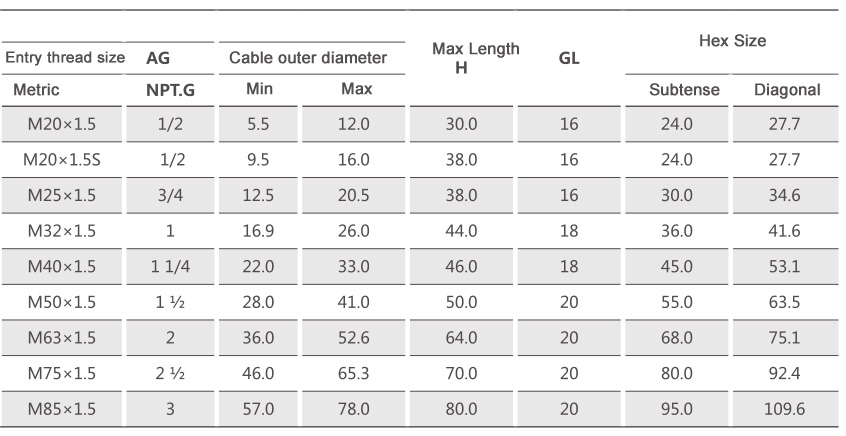

Explosion Proof Control Station, Explosion Proof Control Cabinets, Explosion Proof Panels
Description
• The housing is made of aluminum alloy die-casting, 304 stainless steel plate and carbon steel plate welding, electrostatic spraying or maintain stainless steel color.
• Explosion-proof types include flameproof type, increased safety type and compound type.
• With good dust-proof and waterproof function.
• With overload, short circuit protection function.
• The leakage protection function can be increased.
• Surge protection can be added.
• Inlet direction: the general direction is the next in and out, but also left in and right out, in all directions.
• Installation modes: vertical, hanging and mobile.
• Steel pipe or cable wiring.
Combination: This explosion proof control station includes explosion-proof electric control box unit (fixed size) + increased safety junction box unit (fixed size). The product can be composed of 1 or more explosion-proof electric control box units (up to 6) + 1 or more increased safety junction box units (up to 6). Explosion-proof control panel components such as buttons and rotary switches, as well as observation windows, and cable entry devices can also be installed on the box. As shown below:
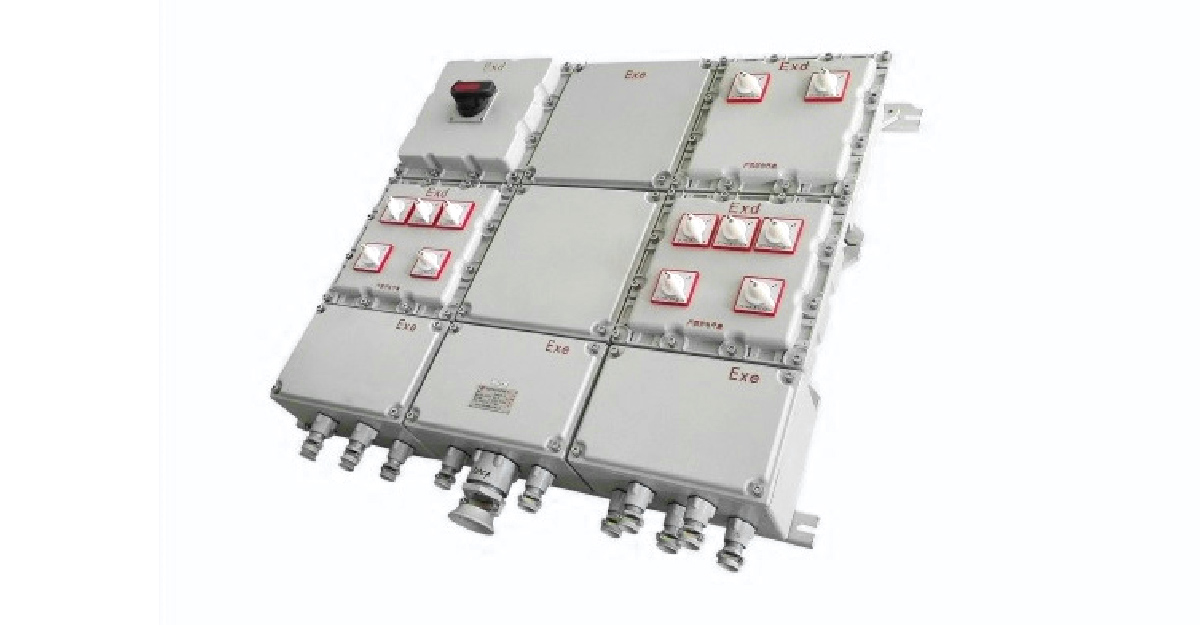
Product show
(* Send your requirement to us if you can not find your suitable products)
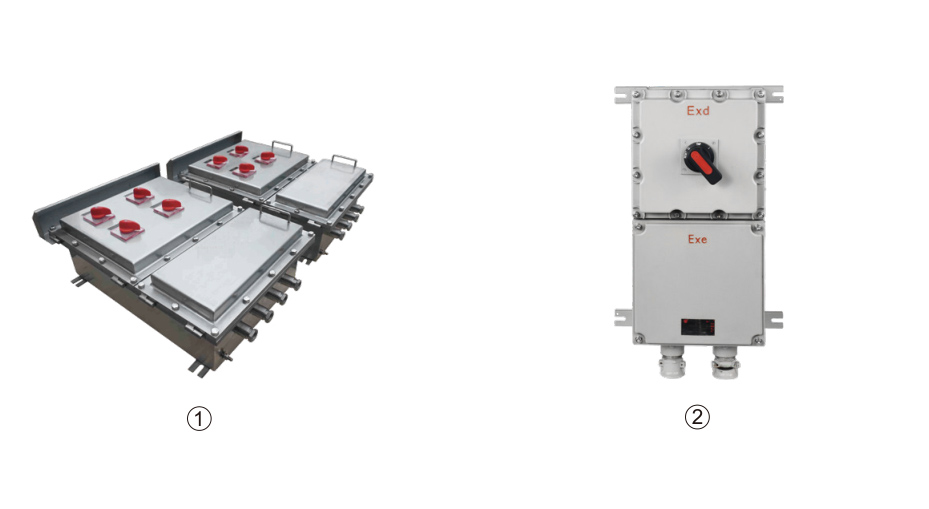
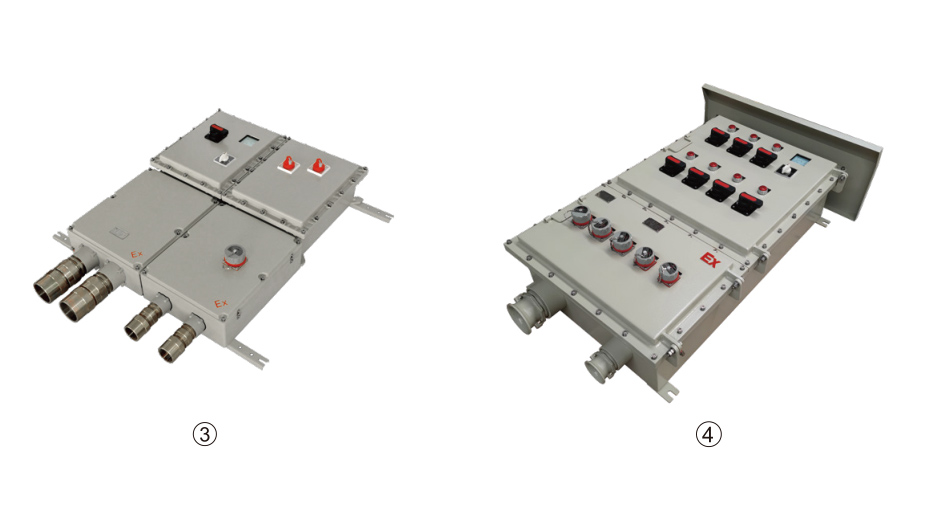
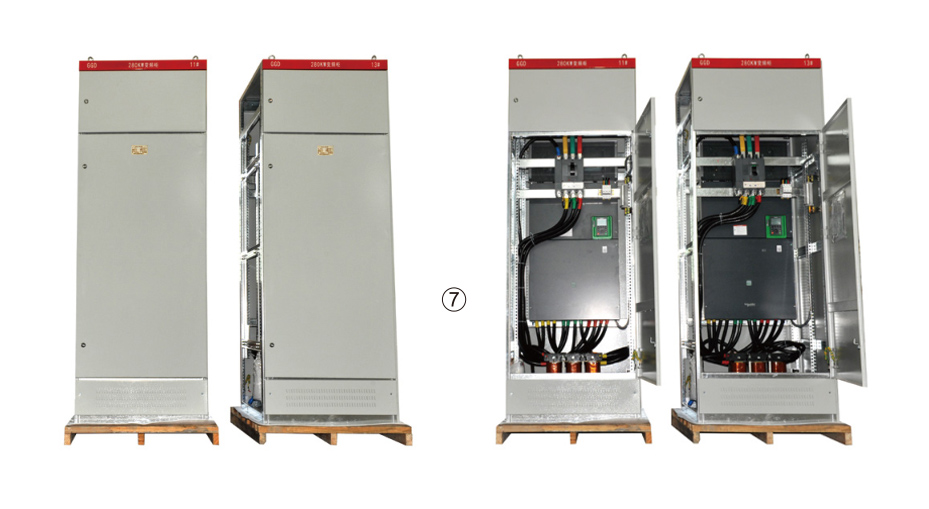
Range of application
●Suitable for explosive gas environment zone 1 ,zone 2;
●Applicable to combustible dust environment zone 21,zone 22;
●Suitable for IIA, IIB, II C explosive environment;
●Temperature classification:T1~T6
●Widely used in petroleum, chemical, metallurgy, medicine and military industry and other flammable and explosive gas environment and combustible dust places.
Technical parameter
●Explosion mark: Ex db eb IIB T4/T5/T6 Gb/ Ex tb IC T80°C /95°C/130°C Db
●Box material: Q235 steel;
●Enviroment temperature: -40°C~50°C
●Input voltage:≤AC480V;
●The maximum working current of the main circuit is 630A;
●Branch current: 1/2/3/6/10/20/25/32/40/50/63/100/125/225/250/400A
●Protection grade: IP66;
●Inlet specifications: G1/2~G4; M20~M90;
●Cable diameter: 中6~80mm
●Explosion-proof components such as signal lights, buttons, rotary switches and terminals have IECEX and ATEX certificates;
Selection

Explosion Proof Junction Box, Explosion Proof Terminal Box
Description
• These Explosion Proof Junction Box is made of aluminum alloy die-casting for the housing, 304 stainless steel plate and carbon steel plate welding,electrostatic sprayingor maintain stainless steel color.
• The wiring terminal adopts international famous brand; Convenient connection. Firm and reliable, and the size of the current has a variety ofspecifications for users to choose.
• Inlet directions are various, and can be selected according to user requirements.
Product show
(* See your requirement to us if you can not find your suitable products)




Range of application
● Applicable to zone 1 and zone 2 in explosive gas environment.
● Applicable to combustible dust environment Zone 21, Zone 22.
● Applicable to IIA,IIB, IIC explosive environment.
● Temperature classification: T 1 to T6.
● Widely used in petroleum, chemical, metallurgy, medicine and military industry and other flammable and explosive gas environment and combustible dust places.
Technical parameter
● Explosion-proof mark: Ex eb IIC T4/T5/T6 Gb and Ex tb IIC T80°C Db
● Material: Box - stainless steel
● Environmental Temperature: -50°C ~ + 60°C
● Electrical parameters: input voltage: ≤AC480V; Rated current:≤400A
● Protection level: IP66
● Inlet specifications: G1/2~G4; M20~M90
● Cable diameter: ф6~80mm
● The terminals with IECEX&ATEX certified.
Dimensions and installation examples
